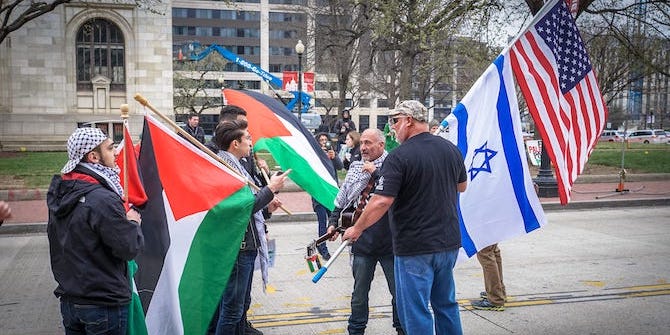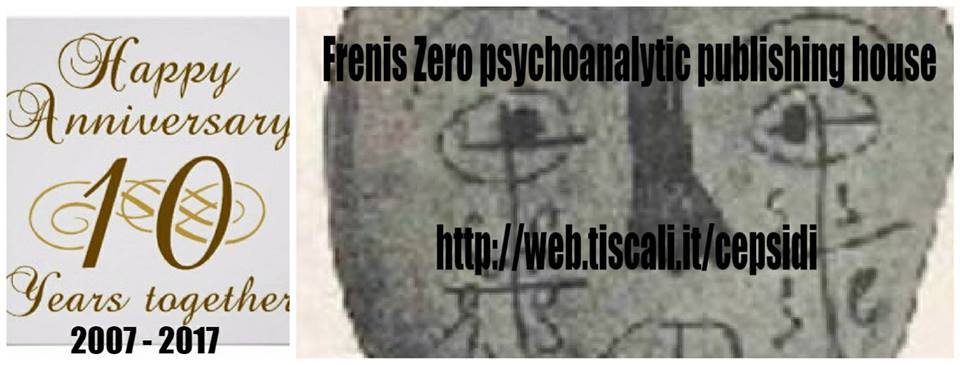| A.S.S.E.Psi. web
site (History of Psychiatry and Psychoanalytic Psychotherapy )
A.S.S.E.Psi.NEWS (to
subscribe our monthly newsletter)
Ce.Psi.Di. (Centro
di Psicoterapia Dinamica "Mauro Mancia")
Maitres à dispenser
(Our reviews about psychoanalytic congresses)
Biblio Reviews
(Recensioni)
Congressi ECM (in italian)
Events (our
congresses)
Tatiana Rosenthal and
... other 'psycho-suiciders'
Thalassa. Portolano
of Psychoanalysis
PsychoWitz
- Psychoanalysis and Humor (...per ridere un po'!)
Giuseppe Leo's Art Gallery
Spazio
Rosenthal (femininity and psychoanalysis)
Psicoanalisi Europea Video Channel
A.S.S.E.Psi. Video Channel
Ultima uscita/New issue:
"Psychoanalysis
in a Holy Land" (English Edition)

Edited by Ambra Cusin & Giuseppe Leo
Writings by: H. Abramovitch A. Cusin
G. Leo M. Roth
M. P. Salatiello V. Volkan
Publisher:
Frenis Zero
Collection: Mediterranean Id-entities
Year: 2024
Pages: 227
ISBN: 978-88-97479-47-5
Click
here to buy the book/Compra su Amazon

"Supervision
and Psychoanalysis" (English edition)
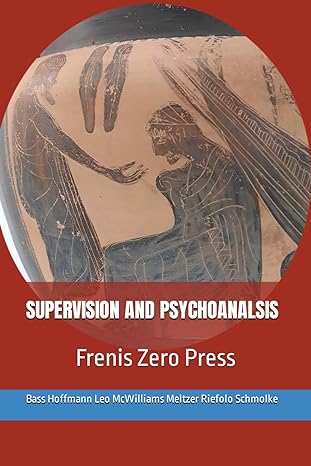
Edited by Giuseppe Leo
Writings by: A.
Bass N.
Hoffmann
G. Leo
N. McWilliams D. Meltzer
G.
Riefolo M. Schmolke et
al.
Publisher:
Frenis Zero
Collection: Borders of Psychoanalysis
Year: 2023
Pages: 200
ISBN: 978-88-97479-46-8
Click
here to buy the book/Compra su Amazon

"Supervisione e Psicoanalisi" (Italian
edition)

A cura di Giuseppe Leo
Scritti di A.
Bass N. Hoffmann G. Leo
N. McWilliams D. Meltzer G.
Riefolo M. Schmolke et
al.
Editore Frenis
Zero
Collana Confini
della Psicoanalisi
Anno 2023
Pagine 210
ISBN 978-88-97479-44-4
Click
here to buy the book/Compra su Amazon

"Why War in
Ukraine and in Europe? Psychoanalysis, Trauma, and Resiliency" (English
Edition)
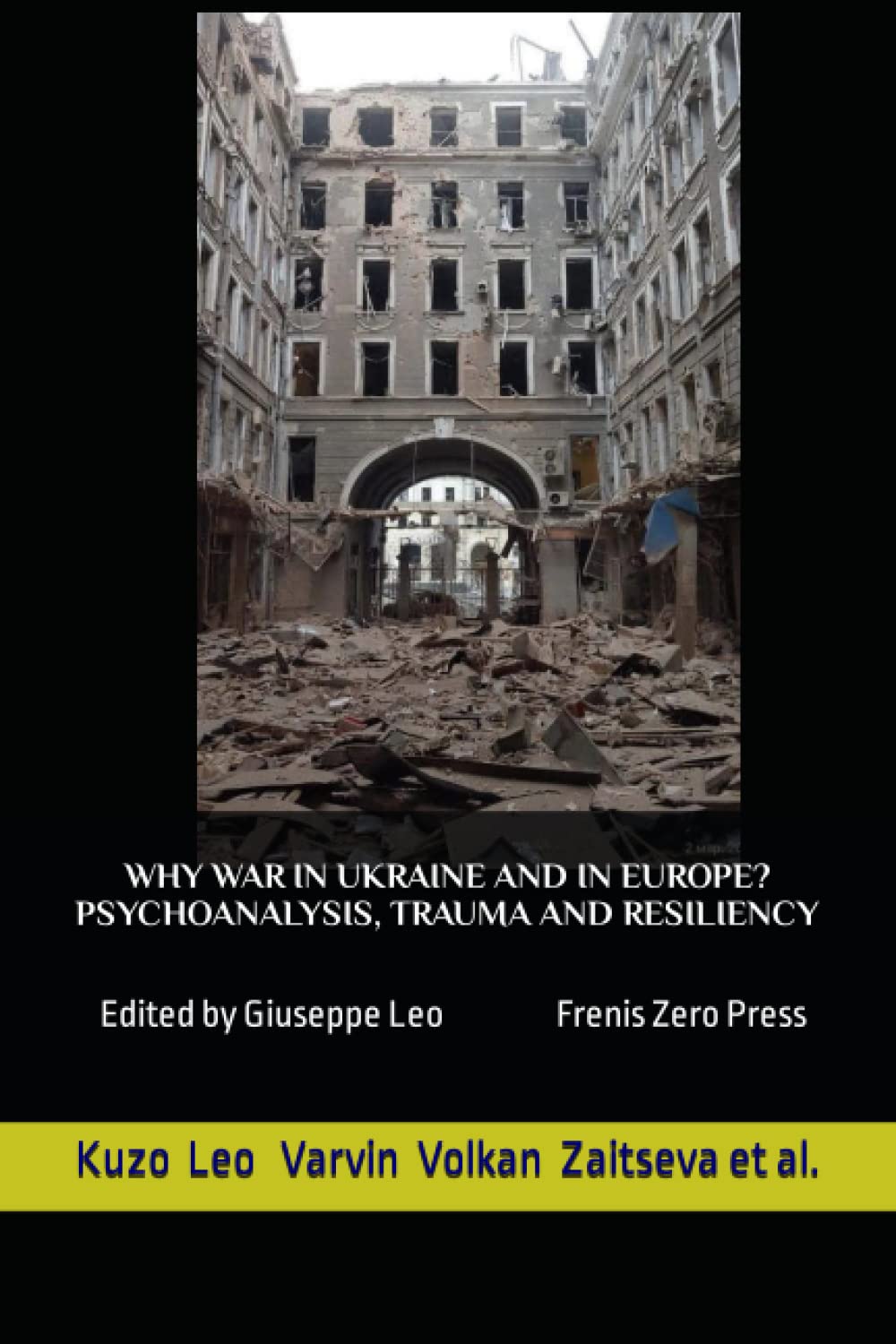
Edited by Giuseppe Leo
Writings by: V. Blikhar N.
Kalka
H. Katolyk L. Kuzo G. Leo
A. Marchuk
M. Tsyvinska S. Varvin
V. D. Volkan K. Zaitseva
Publisher:
Frenis Zero
Collection: Mediterranean Id-entities
Year: 2023
Pages: 235
ISBN: 978-88-97479-42-0
Click
here to buy the book/Compra su Amazon

"Neuroscience
and Psychoanalysis" (3rd English Edition)
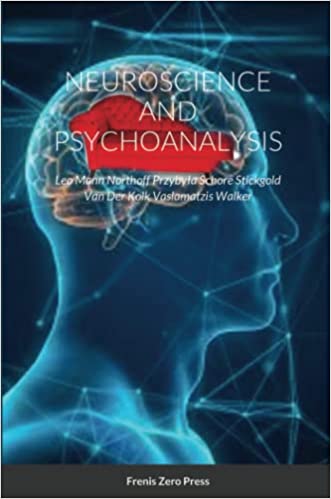
Edited by Giuseppe Leo
Writings by: D.
Mann
G.Northoff
J. Przybyła A. N.
Schore
R. Stickgold B.A. Van Der
Kolk G.
Vaslamatzis M.P. Walker
Publisher:
Frenis Zero
Collection: Psychoanalysis and Neuroscience
Year: 2023
Pages: 321
ISBN: 978-88-97479-40-6
Click
here to buy the book/Compra su Amazon

"Infant
research e psicoanalisi" (ediz. italiana)

A cura di: Giuseppe Leo
Scritti di: B.
Beebe K.
Lyons-Ruth J. P.
Nahum D. Schechter E. Solheim
C. Trevarthen E. Z.
Tronick
L. Vulliez-Coady
Editore: Frenis Zero
Collana: Confini della psicoanalisi
Year: 2022
Pages: 276
ISBN: 978-88-97479-38-3
Click
here to buy the book/Compra su Amazon

"Crisi ecologica e pandemia. Una sfida per la
psicoanalisi"
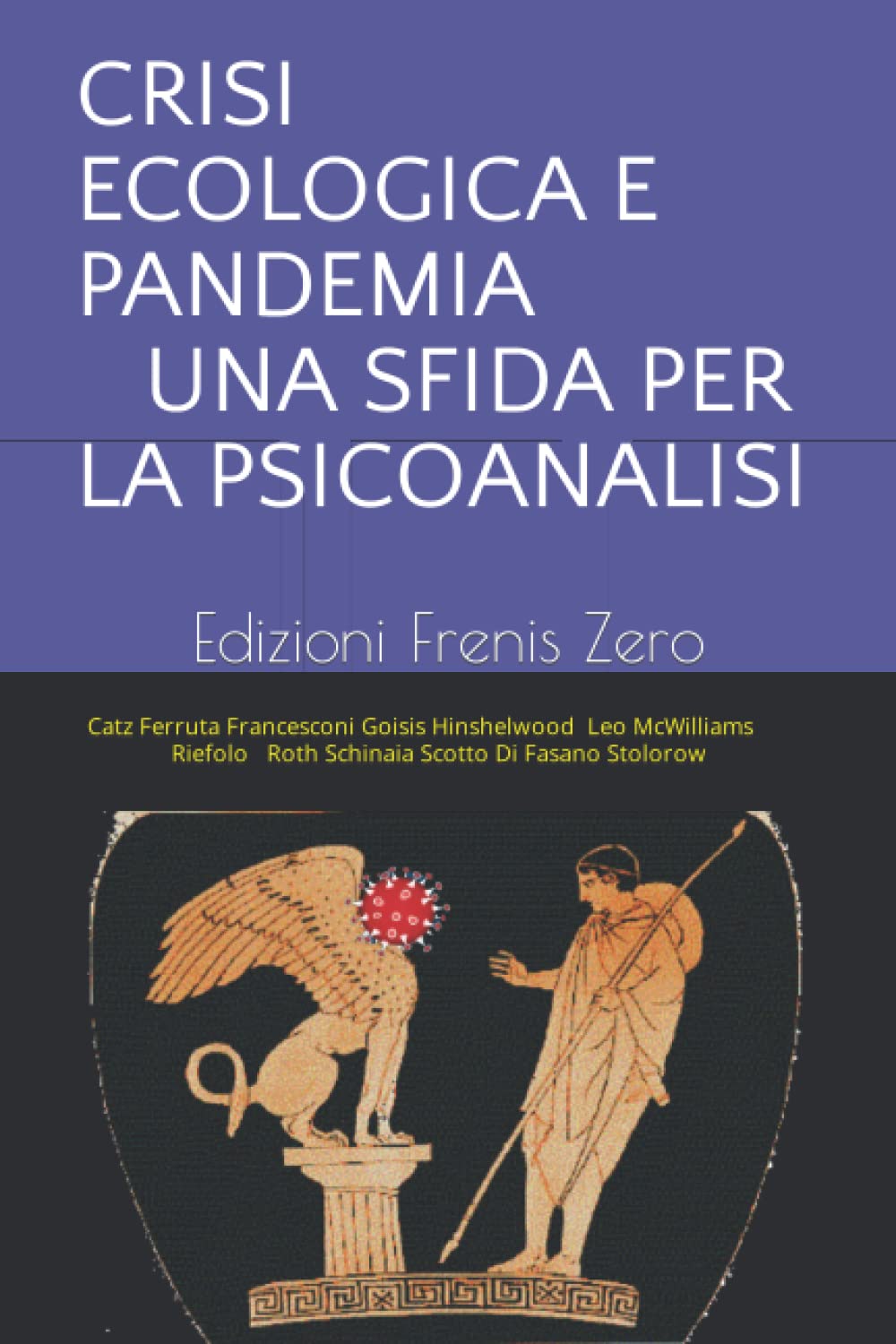
A cura di Giuseppe Leo
Scritti di: Hilda
Catz, Anna Ferruta, Marco Francesconi, Pietro R. Goisis, Robert
Hinshelwood Giuseppe Leo, Nancy McWilliams, Giuseppe Riefolo, Merav
Roth, Cosimo Schinaia, Daniela Scotto Di Fasano, Robert D. Stolorow
Editore: Frenis Zero
Collana: Confini della Psicoanalisi
Anno: 2022
Pages: 268
ISBN: 978-88-97479-36-9
Click
here to buy the book/Compra su Amazon

"Enactment in
Psicoanalisi"
(Edizione Italiana)
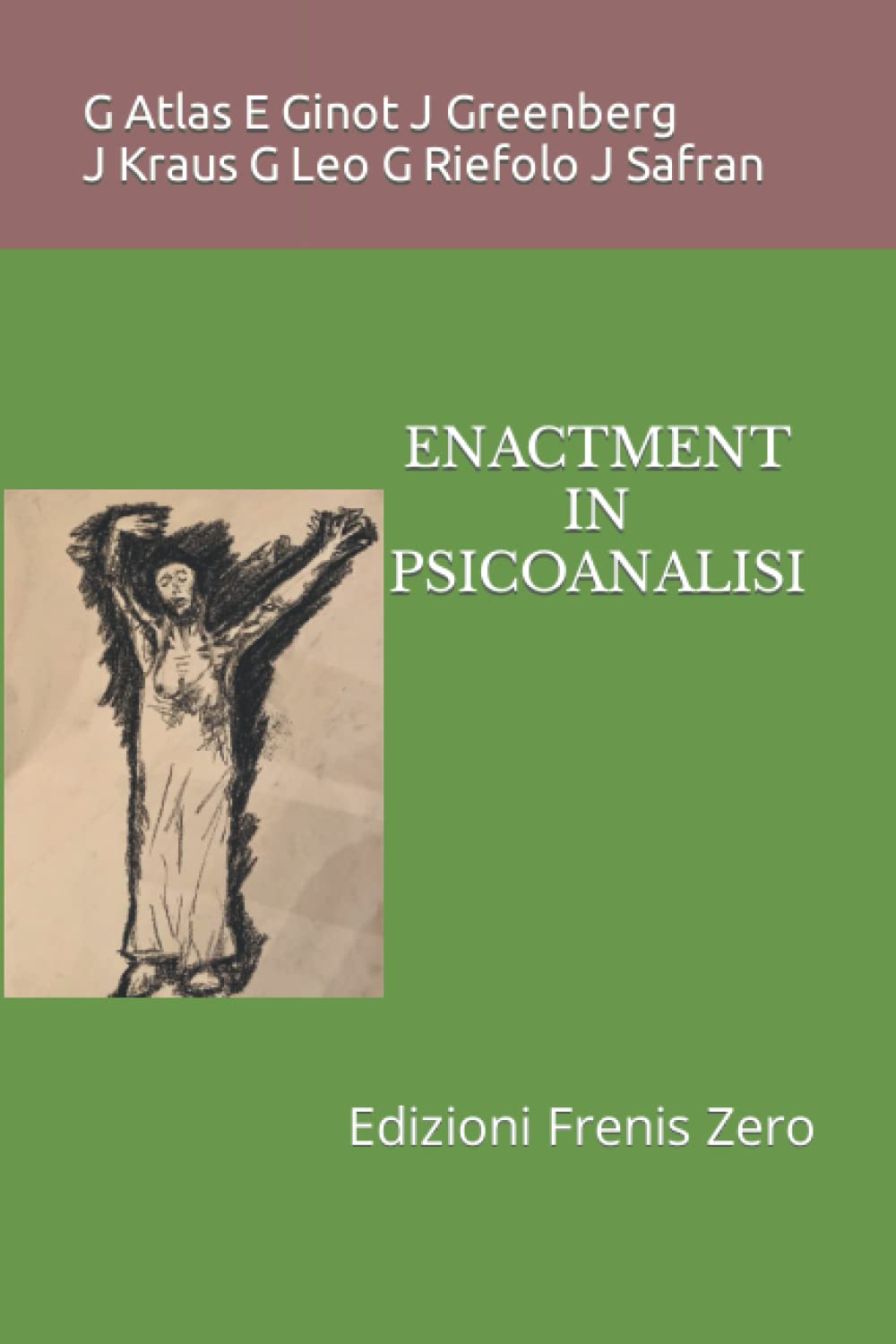
A cura di Giuseppe Leo &
Giuseppe Riefolo
Scritti di: Galit Atlas Efrat
Ginot
Jay Greenberg Jessica
Kraus Giuseppe
Leo Giuseppe
Riefolo Jeremy Safran
Editore: Frenis Zero
Collana: Confini della Psicoanalisi
Anno: 2022
Pages: 320
ISBN: 978-88-97479-34-5
Click
here to buy the book/Compra su Amazon

"Blown Lives. A Tale
for Spielrein, Gross, Tausk and the other losers of
psychoanalysis" by Giuseppe Leo
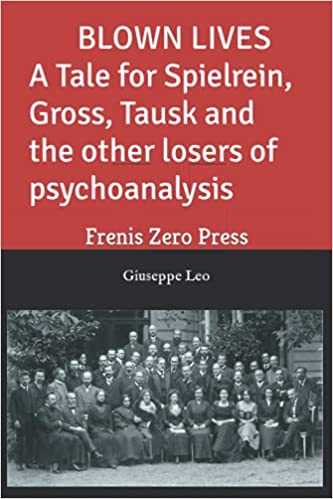
Editore/Publisher: Edizioni Frenis
Zero
ISBN: 978-88-97479-32-1
Anno/Year: 2021
Pages: 284
Click here to buy the
book/Compra su Amazon

"My Ideas Felt Like
Outsize Clothes. A tale for Etty Hillesum" (Second Edition)
by Giuseppe Leo
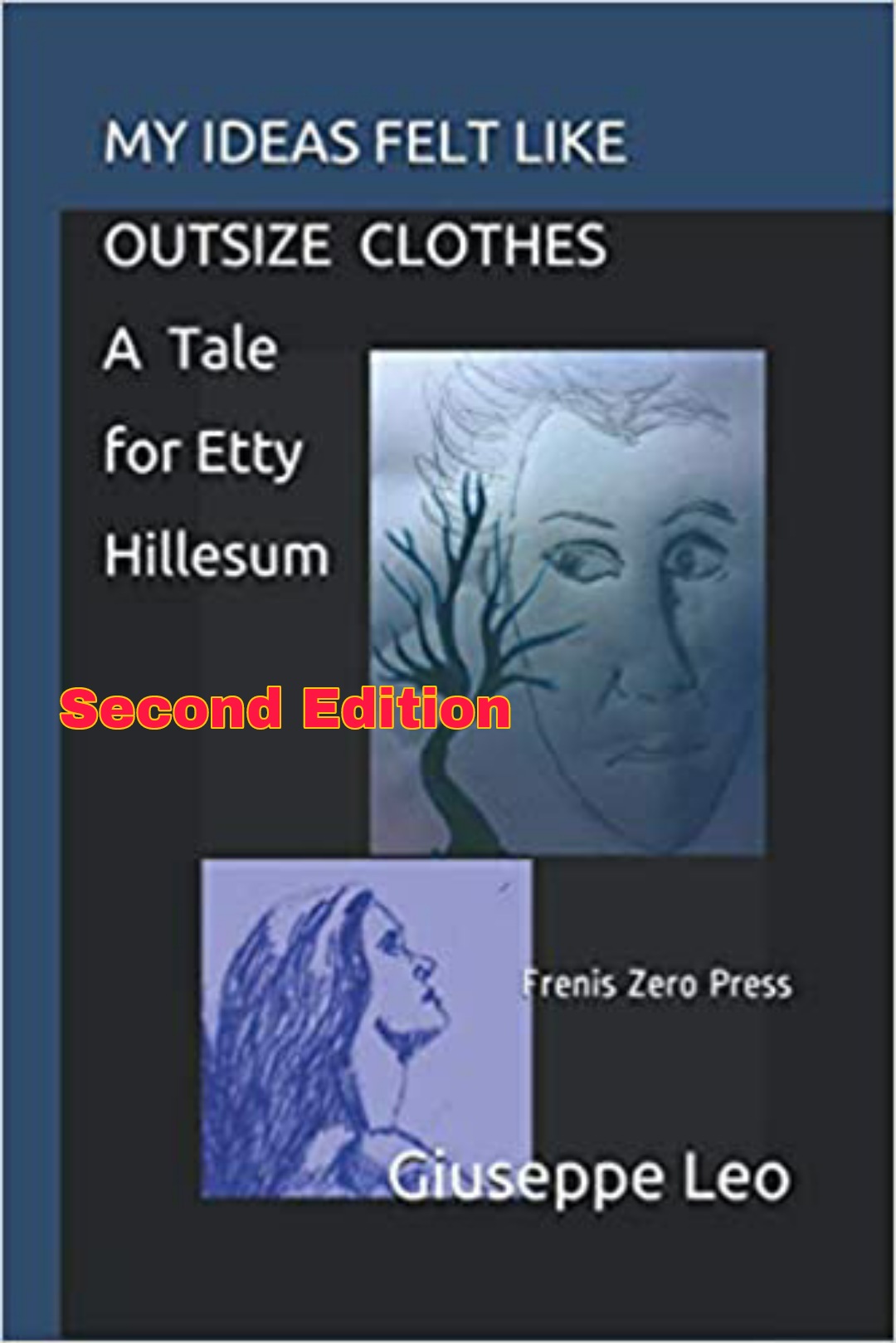
Editore/Publisher: Edizioni Frenis
Zero
ISBN: 978-88-97479-28-4
Anno/Year: 2021
Pages: 128
Click here to buy the
book/Compra su Amazon

"Infant
Research and Psychoanalysis" (Third Edition) edited by
Giuseppe Leo
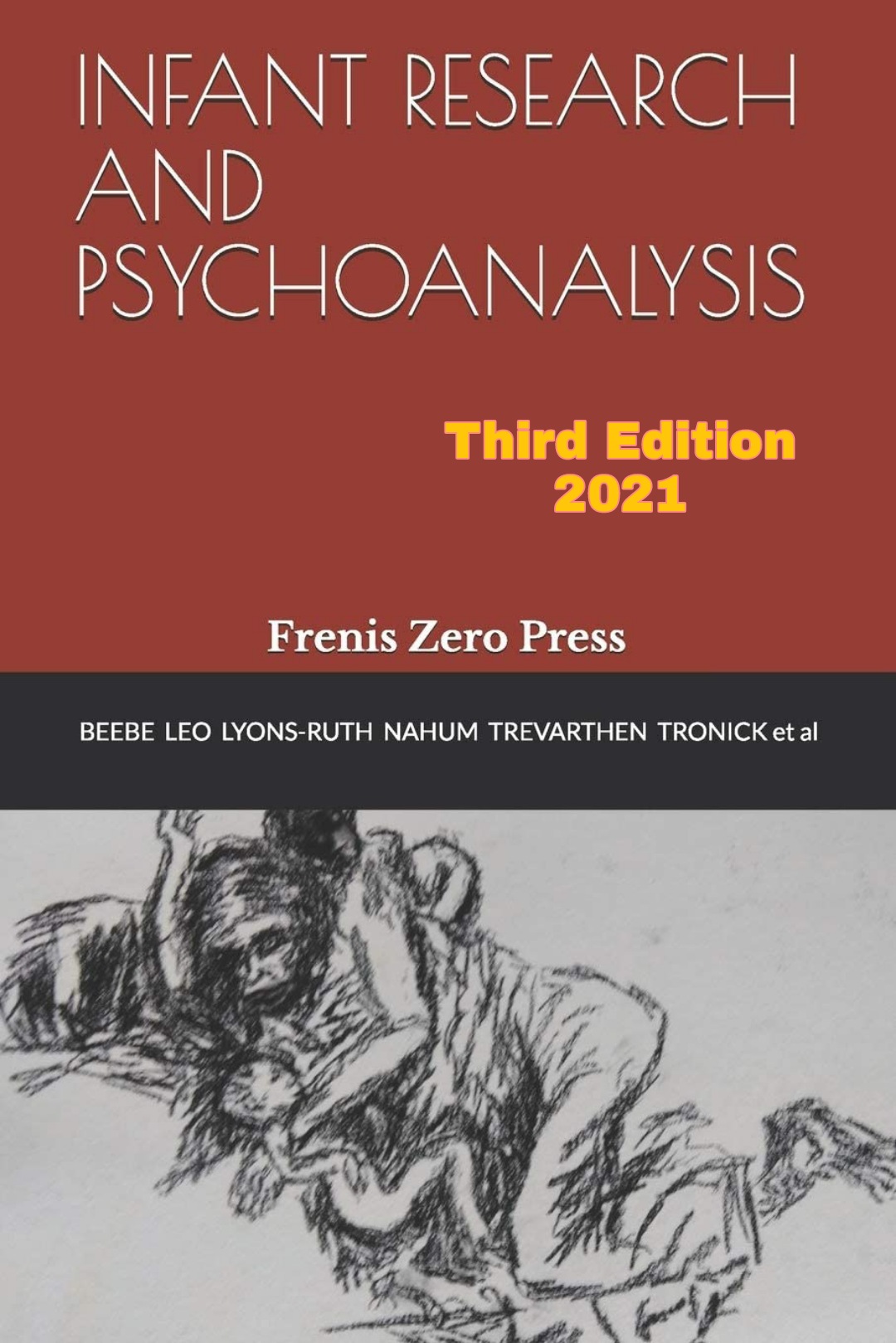
"
Edited by Giuseppe Leo
Writings by: B.
Beebe K. Lyons-Ruth J. P. Nahum D.
Schechter E. Solheim C.
Trevarthen E. Z.
Tronick
L. Vulliez-Coady
Publisher: Frenis Zero
Collection: Borders of Psychoanalysis
Year: 2021
Pages: 285
ISBN: 978-88-97479-24-6
Click
here to buy the book/Compra su Amazon

"Psychanalyse,
Lieux de Mémoire et Traumatismes Collectifs" (Third Edition) edited
by Giuseppe Leo
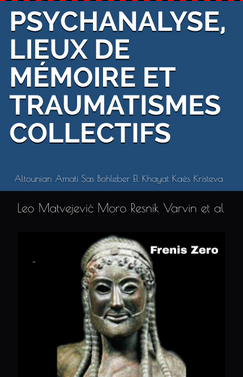
Writings by: J.
Altounian, S. Amati Sas, W. Bohleber, M. El Husseini, R. El Khayat, Y.
Gampel R. Kaës, J. Kristeva, G. Leo, A. Loncan, P. Matvejević, M.-R.
Moro, S. Resnik, S. Varvin
Editore/Publisher: Edizioni Frenis
Zero
ISBN: 978-88-97479-22-2
Anno/Year: 2021
Pages: 546
Click
here to buy the book/Compra su Amazon

"Enactment
in Psychoanalysis" - Second Edition) edited by Giuseppe Leo
& Giuseppe Riefolo
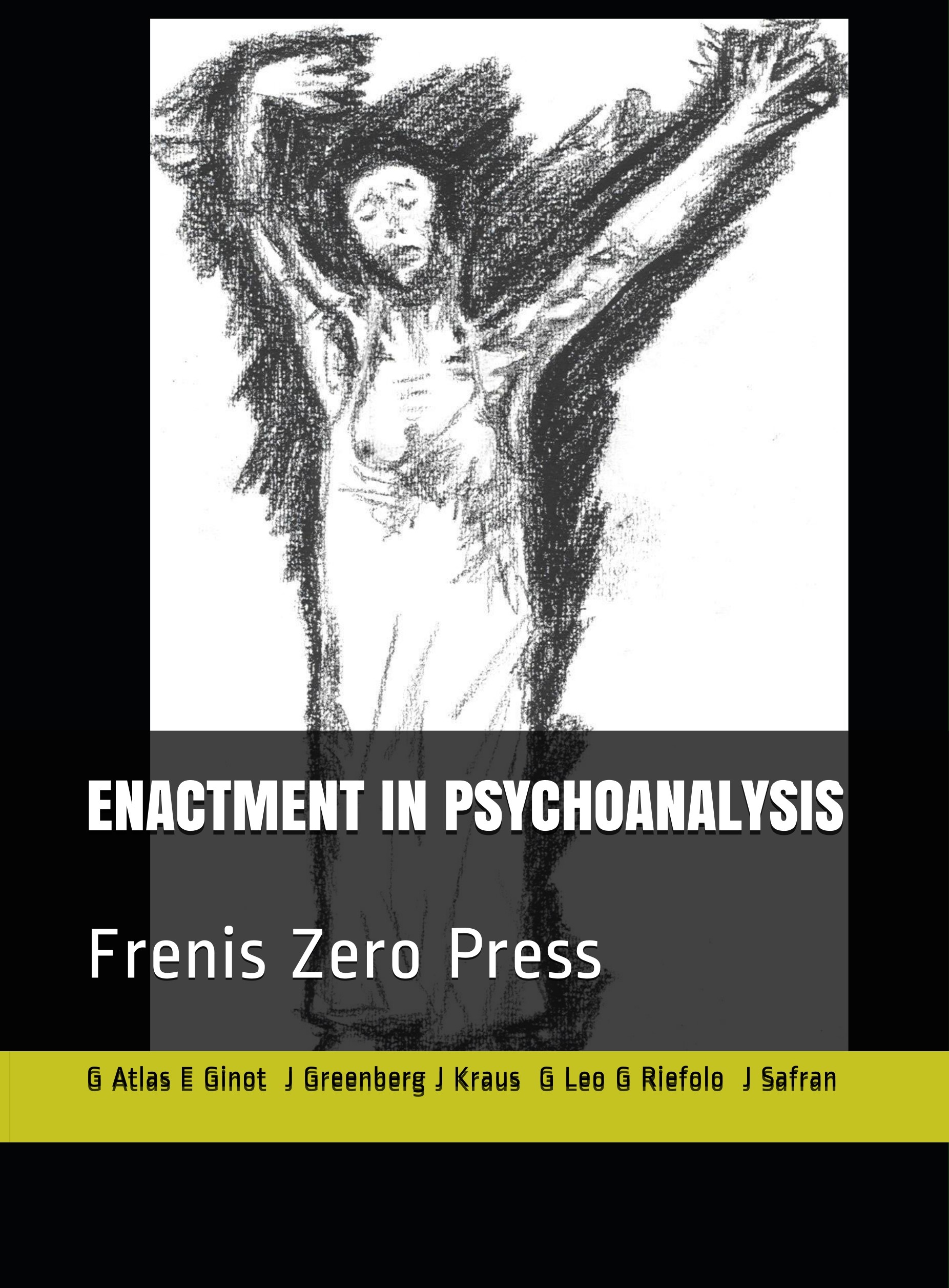
Edited by Giuseppe Leo &
Giuseppe Riefolo
Writings by: G. Atlas
E. Ginot J.R. Greenberg J.
Kraus J.D. Safran
Publisher: Frenis Zero
Collection: Borders of Psychoanalysis
Year: 2020
Pages: 333
ISBN: 978-88-97479-19-2
Click
here to buy the book/Compra su Amazon

"My Ideas Felt Like
Outsize Clothes. A tale for Etty Hillesum" by Giuseppe Leo
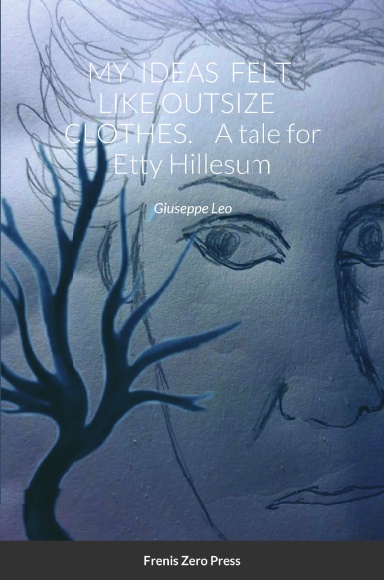
Editore/Publisher: Edizioni Frenis
Zero
ISBN: 978-88-97479-33-8
Anno/Year: 2020
Pages: 122
Click
here to order the book/Ordina
su Lulu

"Environmental
Crisis and Pandemic. A Challenge for Psychoanalysis" edited
by Giuseppe Leo (Second Edition)
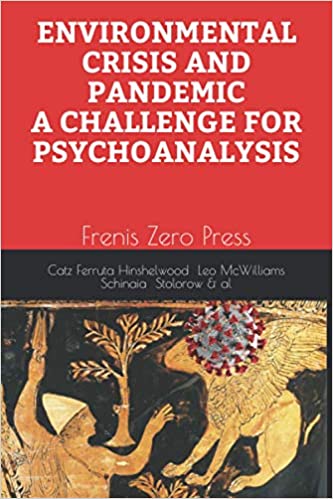
Writings by: H.
Catz, A.
Ferruta,
M. Francesconi, P. R. Goisis, R. D. Hinshelwood, G. Leo, N.
McWilliams, G. Riefolo, M.
Roth, C. Schinaia, D. Scotto
Di Fasano, R. D. Stolorow
Editore/Publisher: Edizioni Frenis
Zero
ISBN: 978-88-97479-37-6
Anno/Year: 2020
Pages: 312
Click
here to order the book/Ordina
su Lulu

Click
here to buy the book/Compra su Amazon

"Psychanalyse,
Lieux de Mémoire et Traumatismes Collectifs" sous la direction
de Giuseppe Leo
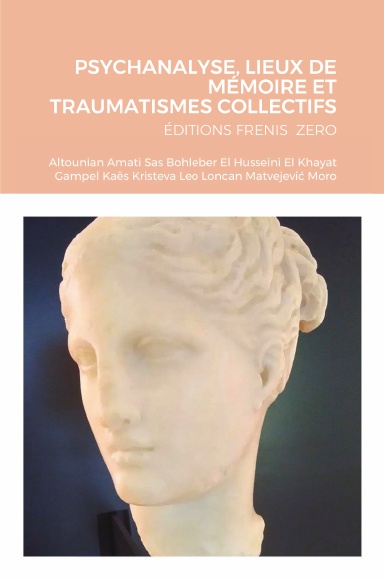
Writings by: J.
Altounian, S. Amati Sas, W. Bohleber, M. El Husseini, R. El Khayat, Y.
Gampel R. Kaës, J. Kristeva, G. Leo, A. Loncan, P. Matvejević, M.-R.
Moro
Editore/Publisher: Edizioni Frenis
Zero
ISBN: 978-88-97479-29-1
Anno/Year: 2020
Pages: 482
Click
here to order the book/Ordina
su Lulu

"Fear
of Lockdown. Psychoanalysis, Pandemic Discontents and Climate
Change" edited by Giuseppe
Leo
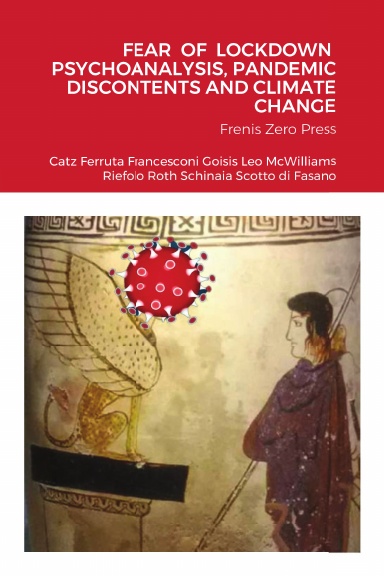
Writings by: H.
Catz, A.
Ferruta,
M. Francesconi, P. R. Goisis, G.
Leo, N. McWilliams, G.
Riefolo, M. Roth, C.
Schinaia, D. Scotto Di Fasano
Editore/Publisher: Edizioni Frenis
Zero
ISBN: 978-88-97479-21-5
Anno/Year: 2020
Pages: 295
Click
here to order the book/Ordina
su Lulu

Click
here to buy the book/Compra su Amazon

"Rock Music & Psychoanalysis"
Second Edition
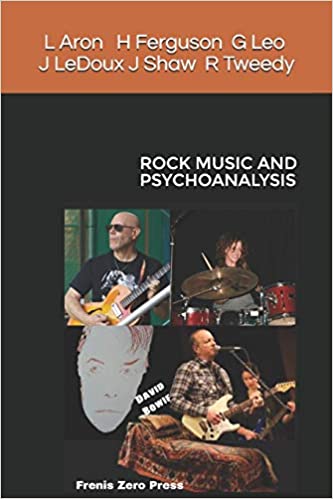
Edited
by: Giuseppe Leo
Authored
by/autori: Lewis
Aron Heather
Ferguson Joseph LeDoux Giuseppe Leo John
Shaw Rod Tweedy
Editore/Publisher: Edizioni Frenis Zero
Collection/Collana: Borders
of Psychoanalysis
Anno/Year: 2020
Pagine/Pages: 221
ISBN:978-88-97479-35-2
Click
here to buy the book/Compra su Amazon

"Essere nella cura"

Authored
by/autori: Giacomo
Di Marco & Isabella
Schiappadori
Editore/Publisher: Edizioni Frenis Zero
Collection/Collana: Confini
della Psicoanalisi
Anno/Year: 2019
Pagine/Pages: 210
ISBN:978-88-97479-17-8
Click
here to order the book
"Enactment
in Psychoanalysis"
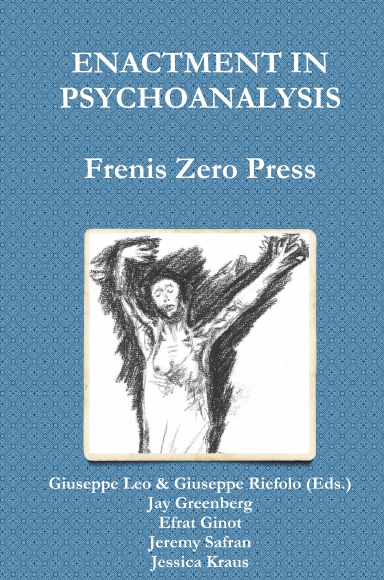
Edited by Giuseppe Leo &
Giuseppe Riefolo
Writings by: E.
Ginot J.R. Greenberg J. Kraus J.D. Safran
Publisher: Frenis Zero
Collection: Borders of Psychoanalysis
Year: 2019
Pages: 326
ISBN: 978-88-97479-15-4
Click
here to order the book
"Infant Research and Psychoanalysis"

Edited by Giuseppe Leo
Writings by: B.
Beebe K. Lyons-Ruth J. P. Nahum E. Solheim C.
Trevarthen E. Z. Tronick L.
Vulliez-Coady
Publisher: Frenis Zero
Collection: Borders of Psychoanalysis
Year: 2018
Pages: 273
ISBN: 978-88-97479-14-7
Click
here to order the book
"Fundamentalism
and Psychoanalysis"
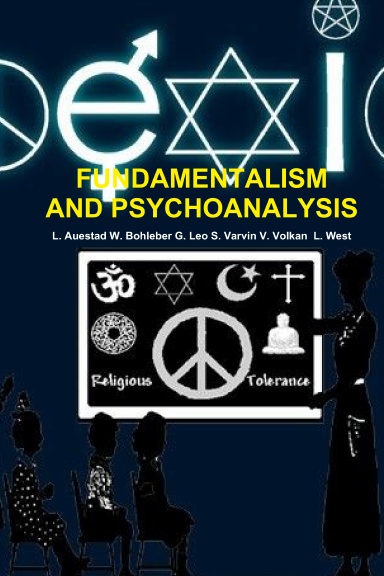
Edited by Giuseppe Leo
Prefaced by: Vamik D. Volkan
Writings by: L.
Auestad W. Bohleber S. Varvin
L. West
Publisher: Frenis Zero
Collection: Mediterranean Id-entities
Year: 2017
Pages: 214
ISBN: 978-88-97479-13-0
Click
here to order the book
"Psicoanalisi,
luoghi della resilienza ed immigrazione"
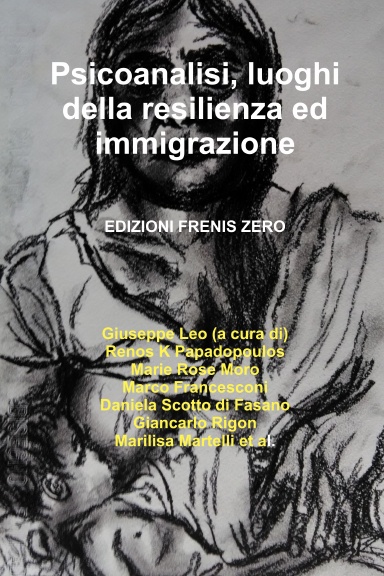
Edited
by/a cura di: Giuseppe Leo
Writings by/scritti
di:
S. Araùjo Cabral, L.
Curone,
M. Francesconi,
L.
Frattini,
S. Impagliazzo, D. Centenaro Levandowski, G. Magnani, M. Manetti, C.
Marangio, G.
A. Marra e Rosa, M.
Martelli,
M. R. Moro, R. K. Papadopoulos,
A. Pellicciari,
G. Rigon,
D. Scotto di Fasano, E. Zini, A. Zunino
Editore/Publisher: Edizioni Frenis Zero
Collection/Collana: Mediterranean
Id-entities
Anno/Year: 2017
Pagine/Pages: 372
ISBN:978-88-97479-11-6
Click
here to order the book
"Psicoanalisi
in Terra Santa"
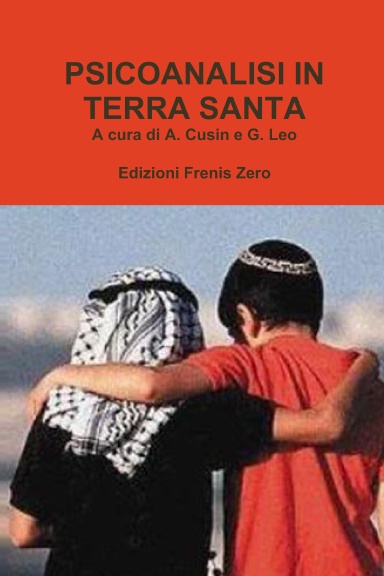
Edited
by/a cura di: Ambra Cusin & Giuseppe Leo
Prefaced by/prefazione
di:
Anna Sabatini Scalmati
Writings by/scritti
di:
H. Abramovitch A. Cusin M.
Dwairy A. Lotem M.
Mansur M. P. Salatiello Afterword
by/ Postfazione
di:
Ch. U.
Schminck-Gustavus
Notes by/ Note di: Nader Akkad
Editore/Publisher: Edizioni Frenis Zero
Collection/Collana: Mediterranean
Id-entities
Anno/Year: 2017
Pagine/Pages: 170
ISBN:978-88-97479-12-3
Click
here to buy the book
"Essere
bambini a Gaza. Il trauma infinito"

Authored
by/autore: Maria
Patrizia
Salatiello
Editore/Publisher: Edizioni Frenis Zero
Collection/Collana: Mediterranean
Id-entities
Anno/Year: 2016
Pagine/Pages: 242
ISBN:978-88-97479-08-6
Click
here to buy the book
Psychoanalysis,
Collective Traumas and Memory Places (English Edition)
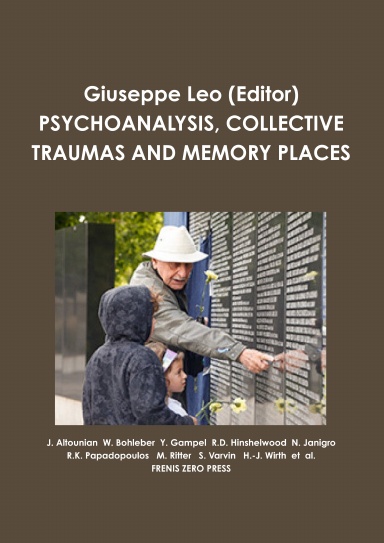
Edited
by/a cura di: Giuseppe Leo Prefaced by/prefazione
di:
R.D.Hinshelwood
Writings by/scritti di: J.
Altounian W.
Bohleber J.
Deutsch
H. Halberstadt-Freud Y.
Gampel
N. Janigro R.K.
Papadopoulos
M. Ritter S. Varvin H.-J. Wirth
Editore/Publisher: Edizioni Frenis Zero
Collection/Collana: Mediterranean
Id-entities
Anno/Year: 2015
Pagine/Pages: 330
ISBN:978-88-97479-09-3
Click
here to buy the book
"L'uomo dietro al lettino" di Gabriele Cassullodi Gabriele Cassullodi Gabriele Cassullo
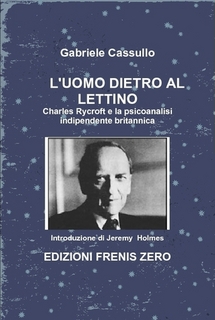
Prefaced by/prefazione di: Jeremy
Holmes
Editore/Publisher: Edizioni Frenis Zero
Collection/Collana: Biografie
dell'Inconscio
Anno/Year: 2015
Pagine/Pages: 350
ISBN:978-88-97479-07-9
Click here to order the book
"Neuroscience
and Psychoanalysis" (English Edition)

Edited by/a cura di: Giuseppe Leo
Prefaced by/prefazione di:
Georg Northoff
Writings by/scritti di: D.
Mann A. N. Schore R.
Stickgold
B.A. Van Der
Kolk
G. Vaslamatzis M.P. Walker
Editore/Publisher:
Edizioni Frenis Zero
Collection/Collana: Psicoanalisi e
neuroscienze
Anno/Year: 2014
Pagine/Pages: 300
ISBN:978-88-97479-06-2
Click
here to order the book
Vera
Schmidt, "Scritti su psicoanalisi infantile ed educazione"

Edited by/a cura di: Giuseppe
Leo
Prefaced by/prefazione di:
Alberto
Angelini
Introduced by/introduzione di:
Vlasta
Polojaz
Afterword by/post-fazione di: Rita
Corsa
Editore/Publisher: Edizioni Frenis
Zero
Collana: Biografie dell'Inconscio
Anno/Year: 2014
Pagine/Pages: 248
ISBN:978-88-97479-05-5
Click
here to order the book
Resnik,
S. et al. (a cura di Monica Ferri), "L'ascolto dei sensi e dei
luoghi nella relazione terapeutica"

Writings by:A.
Ambrosini, A. Bimbi, M.
Ferri,
G. Gabbriellini, A. Luperini, S.
Resnik,
S. Rodighiero, R. Tancredi, A. Taquini
Resnik, G. Trippi
Editore/Publisher: Edizioni Frenis
Zero
Collana: Confini della Psicoanalisi
Anno/Year: 2013
Pagine/Pages: 156
ISBN:978-88-97479-04-8
Click
here to order the book
Silvio
G. Cusin, "Sessualità e conoscenza"
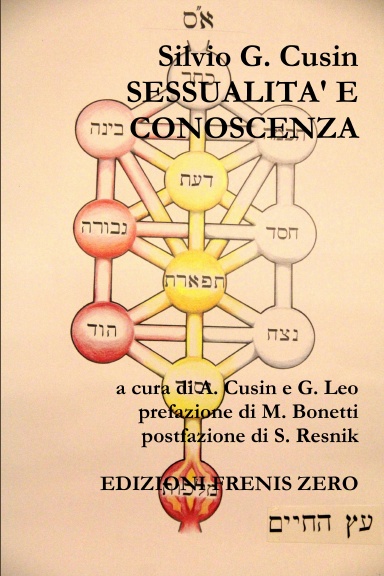
A cura di/Edited by: A. Cusin
& G. Leo
Editore/Publisher: Edizioni Frenis
Zero
Collana/Collection: Biografie
dell'Inconscio
Anno/Year: 2013
Pagine/Pages: 476
ISBN: 978-88-97479-03-1
Click
here to order the book
AA.VV.,
"Psicoanalisi e luoghi della riabilitazione", a cura di G. Leo e G.
Riefolo (Editors)
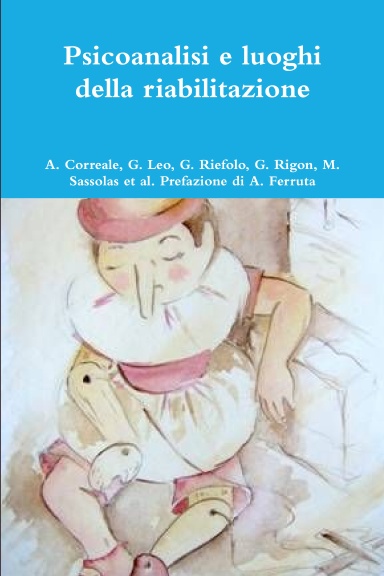
A cura di/Edited by: G. Leo
& G. Riefolo
Editore/Publisher: Edizioni Frenis
Zero
Collana/Collection: Id-entità
mediterranee
Anno/Year: 2013
Pagine/Pages: 426
ISBN: 978-88-903710-9-7
Prezzo/Price:
€ 39,00
Click
here to order the book
AA.VV.,
"Scrittura e memoria", a cura di R. Bolletti (Editor)

Writings by: J. Altounian, S. Amati Sas, A. Arslan,
R. Bolletti, P. De Silvestris, M. Morello, A. Sabatini Scalmati.
Editore/Publisher: Edizioni Frenis
Zero
Collana: Cordoglio e pregiudizio
Anno/Year: 2012
Pagine/Pages: 136
ISBN: 978-88-903710-7-3
Click
here to order the book
AA.VV.,
"Lo
spazio velato. Femminile e
discorso
psicoanalitico"
a cura di G. Leo e L. Montani (Editors)
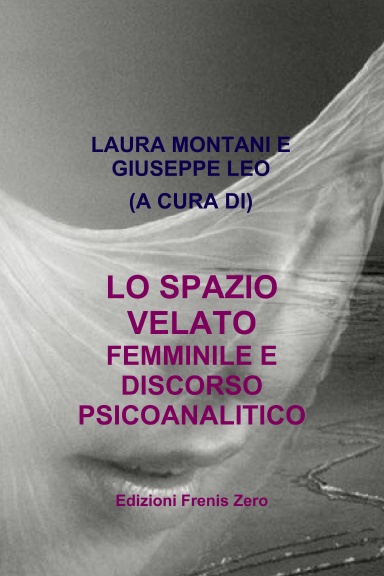
Writings by: A. Cusin, J. Kristeva, A. Loncan, S.
Marino, B. Massimilla, L. Montani, A. Nunziante Cesaro, S. Parrello, M.
Sommantico, G. Stanziano, L. Tarantini, A. Zurolo.
Editore/Publisher: Edizioni Frenis
Zero
Collana: Confini della psicoanalisi
Anno/Year: 2012
Pagine/Pages: 382
ISBN: 978-88-903710-6-6
Click
here to order the book
AA.VV., Psychoanalysis and its Borders, a cura di G. Leo (Editor)
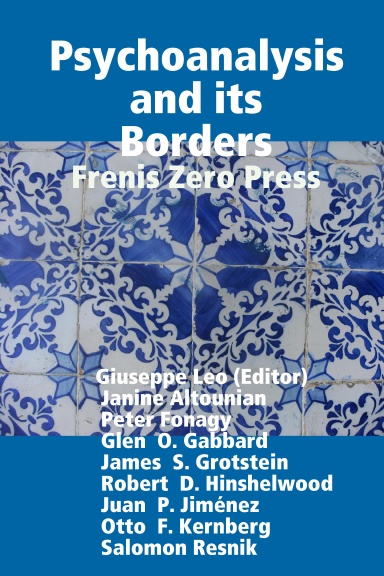
Writings by: J.
Altounian, P. Fonagy, G.O. Gabbard, J.S. Grotstein, R.D. Hinshelwood,
J.P. Jimenez, O.F. Kernberg, S. Resnik.
Editore/Publisher: Edizioni Frenis
Zero
Collana/Collection: Borders of
Psychoanalysis
Anno/Year: 2012
Pagine/Pages: 348
ISBN: 978-88-974790-2-4
Click
here to order the book
AA.VV.,
"Psicoanalisi e luoghi della negazione", a cura di A. Cusin e G. Leo
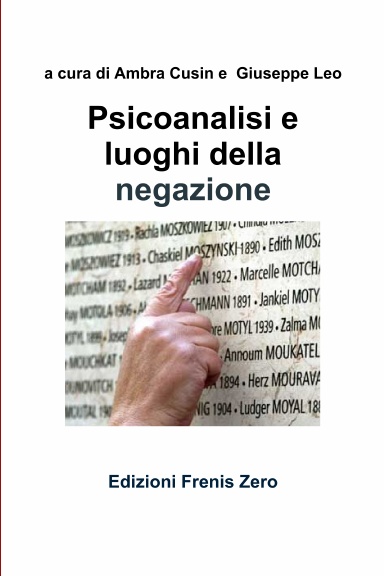
Writings by:J.
Altounian, S. Amati Sas, M. e M. Avakian, W. A.
Cusin, N. Janigro, G. Leo, B. E. Litowitz, S. Resnik, A.
Sabatini Scalmati, G. Schneider, M. Šebek,
F. Sironi, L. Tarantini.
Editore/Publisher: Edizioni Frenis
Zero
Collana/Collection: Id-entità
mediterranee
Anno/Year: 2011
Pagine/Pages: 400
ISBN: 978-88-903710-4-2
Click
here to order the book
"The
Voyage Out" by Virginia Woolf
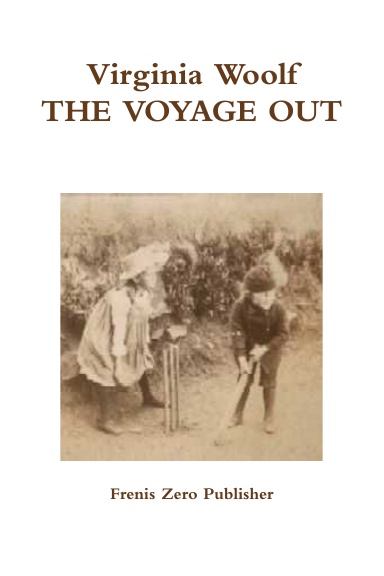
Editore/Publisher: Edizioni Frenis
Zero
ISBN: 978-88-97479-01-7
Anno/Year: 2011
Pages: 672
Click
here to order the book
"Psicologia
dell'antisemitismo" di Imre Hermann
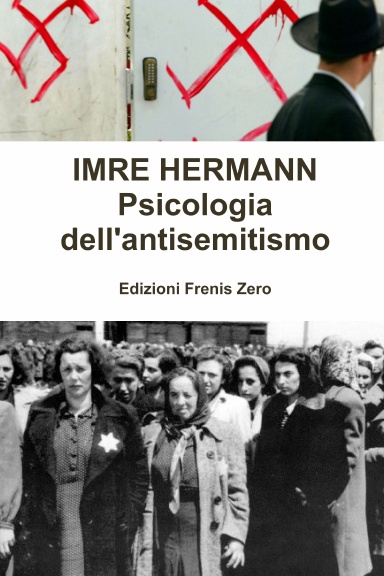
Author:Imre Hermann
Editore/Publisher: Edizioni Frenis
Zero
ISBN: 978-88-903710-3-5
Anno/Year: 2011
Pages: 158
Click
here to order the book
"Vite
soffiate. I vinti della psicoanalisi" di
Giuseppe Leo
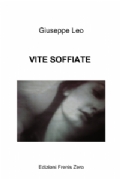
Editore/Publisher: Edizioni Frenis
Zero
Edizione: 2a
ISBN: 978-88-903710-5-9
Anno/Year: 2011
Click
here to order the book
"La Psicoanalisi
e i suoi confini" edited by Giuseppe Leo
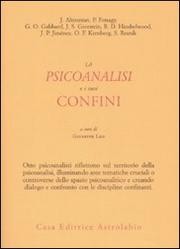
Writings by: J. Altounian, P. Fonagy, G.O. Gabbard, J.S. Grotstein,
R.D. Hinshelwood, J.P. Jiménez, O.F. Kernberg, S. Resnik
Editore/Publisher: Astrolabio
Ubaldini
ISBN: 978-88-340155-7-5
Anno/Year: 2009
Pages: 224
Prezzo/Price: € 20,00
"La
Psicoanalisi. Intrecci Paesaggi Confini"
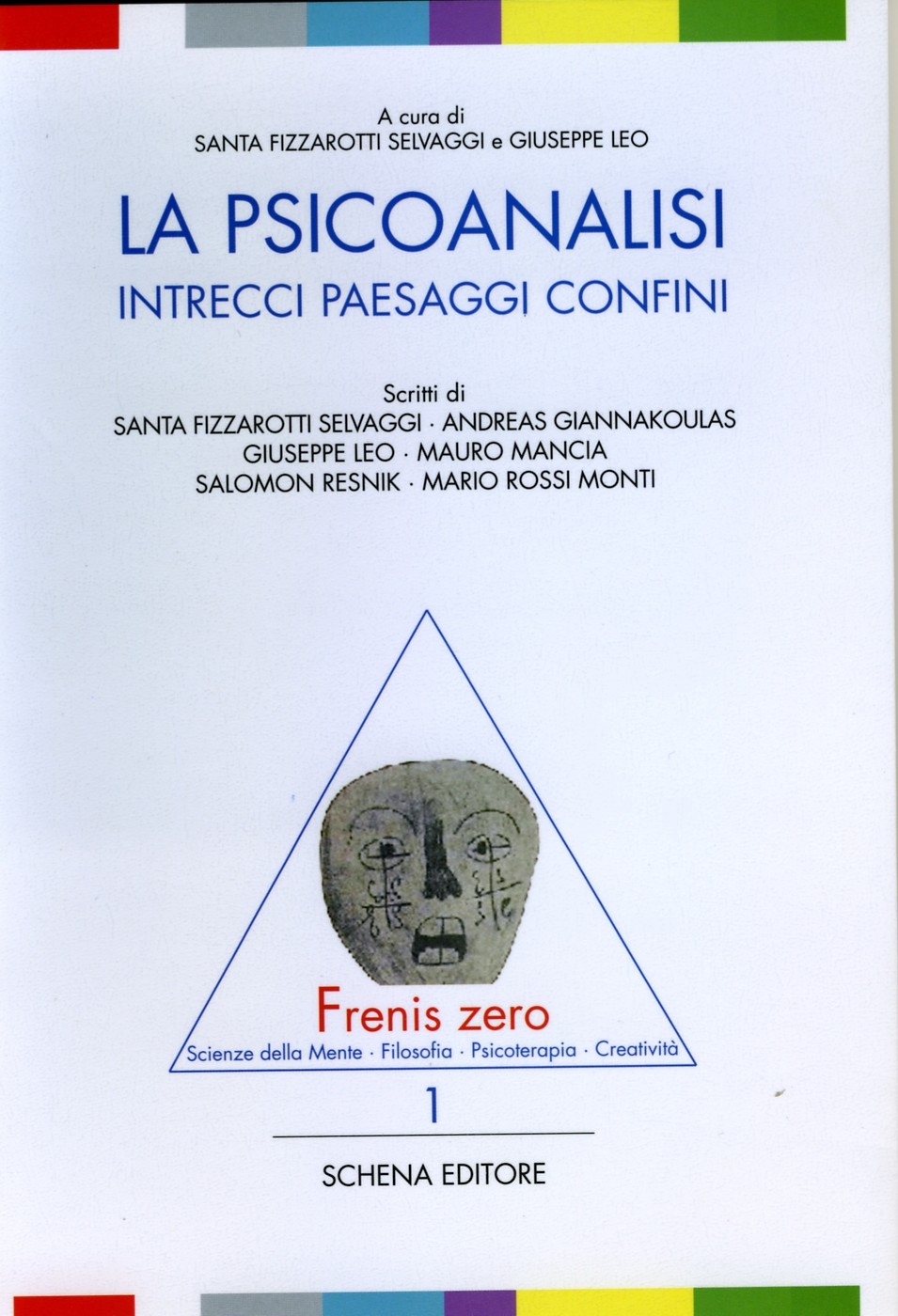
Edited by S. Fizzarotti Selvaggi, G.Leo.
Writings by: Salomon Resnik, Mauro Mancia,
Andreas Giannakoulas, Mario Rossi Monti, Santa Fizzarotti Selvaggi,
Giuseppe Leo.
Publisher: Schena Editore
ISBN 88-8229-567-2
Price: € 15,00
Click
here to order the book
|
“It [the war] hurls down in blind rage whatever bars its way, as though
there were to be no future and no peace after it is over. It tears
asunder all community bonds among the struggling peoples and threatens
to leave a bitterness which will make impossible any re-establishment
of these ties for a long time to come” (Freud, 1915, p. 12).
In times of crises, intellectuals are too easily trapped in adhering
rigidly to their established values and ideas, defending them against
the other`s supposedly inferior perspectives. The results can be seen
impressively in social media discourses, tweets, slogans, declarations
of solidarity and condemnation. There is a strong tendency that
conversations mainly reach the benevolent ears of the in-group, of
those already convinced and seldomly journeying outside their own area
of experience, with a risk of the realities of others being patronized.
The respective starting points, the narrative that one chooses, are too
divergent to have any common ground. In times when the real-time
documentation of cruelties via photography and videos made by their
victims as well as by the perpetrators are more available for the broad
public than ever, the individual sensitivities and ideologies of those
consuming them are highly context-dependent and emotionally charged. On
the one hand, videographic footage seems to be objective as it portrays
what is happening right now in reality, while on the other hand, the
many choices the videographer makes e.g. the frame, the angle of the
video, the duration, remain subjective even to the extent of the
possibility of creating a “faked“ reality. The chosen narrative is the
driving force that determines how pictures are interpreted. This might
lead to a stabilization of our own identity and creation of divisions
against other communities at the same time. The liberal agenda of
autonomy underlying various fragmented identity groups lead to a
feeling of irreconcilable opinions, as well as to a global retreat of a
universal anthropological cohesion and humanistic Weltanschauung, much
needed to survive the many global
challenges such as the climate crisis.
In the following, the metaphor of gazing under fire will be derived by
psychoanalytic observations of the psychosexual development of gaze as
well as the intersubjective experiences, that shape its appearance and
result in its inaccessibility in times of war and hate. Differences
between the look and the gaze will be determined. Subsequently, the
metaphor will be applied specifically to the Israeli-Palestinian
context.
Ideas about inner and outer resistance to war will be developed. The
early dictum by Ferenczi (1988) “without sympathy no healing” will be
proven relevant beyond individual suffering. Without maintaining sparks
of empathy for others, despite the dominance of one’s own suffering,
one will stay stuck in traditional approaches and discourses. The
analytic position of the third, the “negative capability”, interferes
with
hate and correlated belief systems. In critically acknowledging one’s
own aggressive potential and guilt by turning the look at others to a
mutual empathic gaze, communication might become possible.
What a gaze can be about
The subjective experience of a mutually-held gaze is one of the most
profound social encounters, measured by the emotionality it has the
potential to evoke in the gazer. This effect goes beyond the individual
psychological layer. The many writings of philosophers and poets prove
its cultural transmission, and one can find the reverberations of the
emotionality of the gaze replicated in visual and written cultural
artefacts such as in the tales of Oedipus, Medusa or Narcissus.
Apart from its biological roots, according to which the human`s ability
to look is simply understood as the ability to visually perceive and as
a means of attention, its psychological meaning strikes from the
beginning of life. While early phenomenological approaches argued that
seeing comes before words (Berger, 1980), today it is common sense that
seeing is always, and from the beginning of life influenced by its
interface social environment. Through our eyes we establish contact
with the outer world. We create meaning and it is via the encounter of
another’s gaze that we meet the other meeting us (Heron, 1970). The
importance of a child being seen by the primary caregiver for healthy
human development is well known from findings from infant research.
Gaze plays an important role in emotional regulation, as well as the
social learning function of children. Of course, there is more to the
gaze then serving as a prerequisite for learning: It is a part and
expression of our core self (Stern, 1985; Stern, 1974). Through the
direction and duration of our gaze we regulate our emotions: eyes and
gazes can express all basic emotions, including fear or aggression
(Ekman and Friesen, 1974) as well as interactional emotions such as
sexual desire, flirting, love (Bolmont et al., 2014, Bolmont et al.,
2017), challenging and competing (Argyle et al., 1974), power relations
(Hall et al. 2005), dominant and submissive behavior (Tang &
Schmeichel, 2015) or shame and embarrassment (Modigliani, 1971). Riemer
(1955) went as far as to classify the “abnormalities” of the gaze by
defining pathological gazing as not being able to distinguish between
appropriate and non-appropriate gazing behavior, whereas ordinary
social interactants have an intuitive sense of appropriateness.
Extended gazing periods occur particularly in aggressive or libidinal
exchanges. Here, a mutual gaze can dissolve the
difference between subject and object temporarily. To reduce intimacy
on the other hand people prefer to avoid eye contact e.g. in crowded
elevators to preserve the individual space from being intruded on by
others. Gazing behavior is influenced by many other factors than direct
interpersonal relationships e.g., by the gazer`s personality
(Mehrabian, 1972) or by power and status differences (Argyle and Dean,
1965). In recent years, gaze has been further conceptualized in
connection with identities e.g. heterosexual and homosexual gazes, the
“imperial” or the “transatlantic” gaze (Manlove, 2007, p. 84) or the
“colonial” gaze. Here, individual behavior is seen through a lense of
the broader social context, precisely the opposite to the
psychoanalytic inductive perspective, which transfers individual
defense mechanisms to collective reactions.
Gazing in psychoanalysis
With the onset of psychoanalysis, Freud avoided a mutual gaze with his
patients by asking them to lay on the couch, stating that he could not
deal with “being stared at by others for eight hours a day” (Freud.,
1913, p. 131). To access regressive conflicts and fantasies by talking,
the mutual gaze between physician and patient was no longer possible.
First stated in his treatises on sexuality, Freud relates gazing to the
pleasure
principle, a classic drive-theoretical approach.
“Visual impressions remain the most frequent pathway along which
libidinal excitation is aroused. ... It is usual for most normal people
to linger to some extent over the intermediate sexual aim of a looking
that has a sexual tinge to it.”.
(Freud, 1922, p. 156)
“Schaulust” serves Freud namely as a juxtaposition to hysterical
blindness, and an explanation for his psychogenic explanation of
hysteria.
Subsequently, Melanie Klein and other ego-psychoanalysts stressed the
importance of the child`s physical connection to the mother for the
child`s individuation process. Klein understood the gaze to be a
mediator of that early relationship. Concepts of self and other in the
gaze were later prominent in the writings of Lacan (1977). Inspired by
phenomenological approaches like Merleau-Ponty (1962), he states the
pre-existence or reversibility of the gaze. Gazing is not
one-dimensional, as we are at the same time subject and object of our
own gaze. We see only from one point, but are seen in our existence
from everywhere (ibid.).
The gaze represents the object of desire and is furthermore the central
operator of the mirror stage and constitutive for the self. “Reality
needs
to be ordered by formal structures before we can even conceive it”
(Heimann, 2022, p. 710). Through gazing in the mirror, and the
identification with the whole image in it (which is the very bodily ego
that Freud has declared in “the Ego and the Id” (Freud, 1923), the ego
of the child begins to form. Before identification with a caregiver as
an essential
part of the social development is possible, one needs to experience a
feeling of difference (in contrast to fusion) to the object. The
interaction with the other is essential for the child to develop a
self. The mirror is not just a reflection of our physical selves, but
the insight that, if we can see ourselves, others can also see us. This
form of being observed by the imagined other is of primary importance
for our self-awareness and being. The gaze as one operation in this
mirror function is an essential part of human desire. Gazing towards
another object marks our object of desire. The subject desires to be
desired by the other. The gaze of the other is always present, even if
the subject is alone. Thus, the gaze cannot be tied to a specific real
person gazing, but is always influenced by one’s own fantasies about
the other seeing us. Since the 1970s, and with the growing popularity
of infant-observation research as part of an intersubjective and
inter-relational psychoanalytic framework, the topic of mutual gazing
gained popularity. Starting off with the famous still-face-paradigm
(Tronick et al., 1978), today there exists an ample amount of
literature on gaze avoidance in infants towards their mothers and later
on their psychoanalysts. This is mostly interpreted as early
psychological defense mechanisms to regulate distress as experienced in
the caregiving situation (Coswill, 2000; Salomonsson, 2016; 2021).
Intersubjective theories focus on encounters and relationship experiences
in early life and how they form our way of being with others in
adulthood. If an early narcissistic vulnerability or oral deficiency
comes into play, then one is susceptible to counter-movements such as
aggression and anger. In general, the couch setting and the elimination
of the mutual gaze in psychoanalysis intensifies deliberately the gaze
inwards, the introspection that is necessary for working through
psychologically relevant conflicts. At the same time, fantasies and
projections towards the imagined quality of the gaze of the analyst
intensify. Both aim at the emergence of the second, unconscious layer
of conversation, the psychoanalytic mise-en-scene guided by inner
conflicts. The same principle is true for the collective, instead of
acting-out negative emotions
towards the outside, a society will not overcome their collective trauma
whithout a working-through of the traumatic past (LaCapra, 2001). Too
often, this gaze is blurred by hate.
The look of hatred
“The man who first flung a word of abuse at his enemy instead
of a spear was the founder of civilization.” (Freud & Breuer,
1893)
Violence is a universal human reaction to our innate human dependence,
and the “manner in which we are “given genders or social categories,
against our will and subjectivized in the context of the repetition of
insistencies that construct us according to the dictates of power”
(Butler, 2009, p. 167). While Butler’s conceptualization as humans is
mired in violence from the beginning, other authors, mainly
humanistically informed, do not conceptualize violence as an innate
human trait. Violence occurs exclusively as a reaction to the failure
of needs, and is only indirectly referred to in the context of power or
violation of autonomy. Through its many diverse appearances, hate is an
existential part of our human condition, psychoanalytically rooted in
the destruction-seeking “Thanatos” drive. At least since Winnicott’s
work on “Hate in the countertransference” (1994), intersubjective, ego
—and self— psychoanalysts are convinced that hate is necessary for the
psychosexual development, for self-realization and even as a therapeutic
tool to work-through in therapies.
The psychologically most relevant division is the one between hate
directed towards the outside and a hate that is directed inside. When
aggression is absent or turned inwards, the death drive energy is
transformed into depressive stagnation and indifference instead of being
channeled towards the other person. This can be expressed either in a
hostile attitude, or in resignation and depression, and in the most
extreme
form, in suicide. Anger is a vital force, whereas depression is the
opposite. Resentment can be understood as a mixed form between inside
and outside hatred. In war, hate is mainly male and loud – war as a
man`s game (Virginia Woolf), women are rather the bystanders and
victims of male aggression. Theweleit (2015) referred to the worst
cases of the male desire to kill as “free floating SS-men”. He mentions
Anders Breivik, ‘..the Norwegian neo-Nazi terrorist, who saw himself as
a healer cleaning the world, a recurrent fantasy in transfigurations of
terror attacks of individuals. There are some psychological
characteristics that differentiate hate from anger (Fuchs, 2021; Blass,
2019). In hating someone, the other holds a very powerful position. The
absolute wish to destroy the other occurs alongside a form of
self-emptying and is destructive. A more constructive form of anger
could be self-defensive, includes fantasies of superiority, of wishing
oneself a better life (a progressive feeling) versus hate that is
directed towards annihilation, destruction, and powerlessness (a
destructive feeling). The more persistent the feeling of injustice, the
more likely it is to experience hate. Hate is an obsession, a
progressive self-poisoning directed towards one’s soul.
The greater one’s own suffering, the more inadequate and difficult the
endeavor is to move from a projective position (which sees the guilt
and fear in others) to a depressive position (which mourns one`s own
shortcomings). In direct contact between hostile parties (in a manner
similar to libidinal contacts), the gaze is attached to the object as
if in a form of perversion. The hater cannot let go of the powerful
object he or she hates and wishes to destroy. This is specific to the
psychoanalytical approach to hatred: it is not so much about the object
of hatred itself, but about inner reasons and vulnerabilities in the
person who hates. In the concept of destructive narcissism, hate can be
understood as a form of traumatic re-enactment. The relationship
between trauma and hate lies in the victim perpetrator reversal. In
hatred, the aggressor is the strong character, and the weak target is
despised. Hating is the reversal of weakness into strength that makes
the individual feel (temporarily) strong. Instead of turning the gaze
inwards by facing narcisstic injuries in oneself, the gaze turns
towards the outside, the other is devaluated and the own position stays
untouched.
Hate and trauma in the Israeli-Palestinian context
How does hatred manifest itself in a country in which both parties are
socialized with a narrative in which they are “victims” –and, of
course, are too often indeed real victims from one side or the other–
feeling hindered in their aspirations for advancement and furthermore
feel united in the feeling of being devalued worldwide? What about a
society such as that of the Palestinians, who have been deprived of
their own space since the Nakba in 1948, or the Jews, who had to search
for their destroyed space anew after the Shoah? The specific historical
and social
consistent traumatic Israeli-Palestinian context is susceptible to
hate, projections, identity negotiations in both gruops. Here, social
experiences
of flight and migration, as well as individual experiences of impediment,
enter a disastrous resonating relationship, reinforcing each other. The
experience of collective violence results in living in an ongoing
survival mode (Chemtob et al., 1988). Such a mode is defined in terms
of a cascade of neurobiological responses that make the organism ready
for the fight-flight response as well as for bonding (Brom, 2014).
In existential threatening situations, attachment to benevolent authority
is an essential survival mechanism (compare the early infant and
caregiver situation). At the same time, just as the attachment is
strong, there is a parallel tendency to reject people perceived to be
hostile or not
part of the in-group (ibid.). Violence could be even used to assert
that one’s own view of the world is the correct one. As violence is
justified as a moral act, one demonstrates that one’s own normative
claims are justified. Shared hate can further serve as a strong
foundation for group
identities and there is limited capacity to look beyond a benevolent versus
hostile dichotomy.
As noted earlier, hatred arises precisely in the gap where the individual
does not find its place to develop, where personal mortification and
unresolved mourning occur. The ongoing traumatic environment of
violence constitutes a victim state of mind, with paranoid-schizoid
mechanisms (Hollander, 2015). Both Israeli Jews and Palestinians suffer
the psychological consequences of occupying a position of victimhood, a
psychic state that tends to produce diminished self-esteem, a defensive
grandiosity, wishes for revenge, a need for compensation resulting from
feelings of entitlement, and the splitting of good and evil between
self and other that prevents empathy (Hollander, 2015, p. 64). Defenses
against mourning (or the depressive position) often include
identification with the aggressor, personified in belligerent and
bellicose political leaders or organizations that can protect the group
from (re)experiencing the humiliation of powerlessness (Falk, 2004).
The similarities between the too similar “brothers” –the Jewish and
Palestinian people– are described often. Both suffer from deep
narcissistic injuries, driven by the compulsive repetition of trauma
and intergroup dynamics, both strongly attached to their respectively
claimed homeland and eventually leading to fratricide. Today, these
similarities might be seen as a cliché, and yet are more accentuated.
Both Palestinians and Israelis are in a status of massive trauma, which
intensifies the feeling of being victimized.
The Palestinian people are categorized as being the “victim of the
victim” or being in a state of “competing victimhood” (Shnabel &
Noor, 2012), a competition about being the “true” victim. and
proposing. Another conceptualization, the “chosen trauma” (Volkan,
2007), describes the identity-forming state of mind of a people through
the trauma that was passed on through generations before who fought in
this land. The clinging on to the “chosen trauma” of ancestors could be
understood as a (often unintended or unconcscious) resistance to peace,
especially when violence is involved as the projection of one`s own and
collective vulnerability as mentioned before. Again, hatred is an
(illusionary) way
to compensate for humiliated self-esteem, because one’s own group
appears superior and unique in comparison to the devaluated group of
the other. Hate consists of a reversal: at the root of hate lies
humiliation,
loss of honor, and loss of face, devastating experiences that threaten
self-esteem. Collectively speaking, hatred towards the outside serves a
rescue function in which aggressive energies are released. The threat of
self-destruction is transferred to the destruction of the other. Fatally, the
two hostile parties need each other to stabilize their identity and
world views. Next to trauma, hate can also be passed on to future
generations if not —as a first step— active gazing under fire is
practiced, later followed
by actions of a needs-based-model of reconciliation which could have the goal of breaking the cycle of competition.
Gazing under fire
The concept of “thinking under fire” was coined by the psychoanalyst
Wilfred Bion (1962) who suffered himself from posttraumatic conditions
after his experiences as a tank commander in the First World war.
Ever since, it has been a popular metaphor for describing the rising
emotional pressure and intensive feelings experienced by therapists
during the real-time treatment of their patients, with the task of both
containing these emotions in themselves, as well as reacting adequately
to those of their patients. The willingness to allow the deepest and
most frightening aspects of a patient’s inner world to emerge in the
encounter
(Bion, 1967a) is also described as a “negative capability”. This capability
entails entering into the encounter with the patient with “no memory no
desire” (Bion, 1967b), to immerse oneself in the reverie of the moment,
and to not be too influenced by preexisting theory or prejudice.
This process aims to deepen the engagement with whatever is in the
patient’s mind during the therapeutic encounter. Thus, it might be so
difficult for psychoanalysts to comment on political topics because
they are used to being in this observing, reactive and distanced
position. In the following, the metaphor of gazing under fire will be
applied to the war situation, where we as observers are forced to look
and testify the atrocities being committed.
As mentioned before, in war and trauma, early defense mechanisms such
as splitting, denial and projection are effective. Those are driven by
the existential fear (Rosenfeld, 1971) which the traumatic event
arouses to an intolerable extent. It is extremely hard for those
immediately affected and traumatized to be empathic to the pain of the
other side, exactly because the level of one’s own suffering is so
high, and it occupies the whole mind in thinking and feeling. Although
the level of empathy increases with the magnitude of pain of each
individual, there is no increase in empathy regarding the number of
people suffering (Gordon-Hecker et al., 2024). This is refered to as
the singularity effect: paradoxically, the level of empathy a single
(identified) victim attracts more empathy than a group of victims
(Kogut & Ritov, 2005).
Beyond individual empathic responses, the regressive pull of war further
sweeps us in large group dynamics. Just as at the individual level,
one’s primitive (narcissistic) vulnerability can be externalized in
group conflicts (Volkan, 2007). Well known are Bion’s
“basic-assumption-groups” (1961), characterized by the basic
assumptions of fight or flight (group unites to fight against or flee
from), pairing groups (wish for pairing of two separate parties) and
dependency groups (submission under an omnipotent leader). Bion judges
the behavior of the groups as a regressive defense against psychotic
and “dreadful” fears, feeling helpless in a dependent regressive
position. These group states are highly influenced by Freud’s group
psychology and the analysis of the Ego, where the masses lose their
individual ego and instead, affected by the masses` emotions,
narcissistic libido is transferred to an idealized leader.
Also, in Bion’s conceptualization, a leader (“a father figure”) unites
the groups with different individual positions towards this leader.
For bystanders, for persons not identifying with one of the groups or a
leader, such as media consumers who watch hate crimes on social media,
the risk is high of experiencing shock and shame looking at pictures
without being able to do something about the helplessness provoked.
This kind of looking could produce a feeling of voyeurism. Also the
felt sense of vulnerability is very high when confronted with traumatic
situations, and might be easily projected on the other by intergroup
processes. On the other hand, those standing outside the immediate war
situation are also able to take on the psychoanalytic third perspective. A
psychoanalytic-informed search for meaning and understanding should
not be considered as a form of escapism with regard to political or
personal moral responsibility. Instead of patronizing reality from an
ivory tower, genuine conversations depend on mutual recognition.
Ideally, this position will not lead to simplistic answers, but rather
reveal complex and ambivalent answers which hold different truths at
the same
time. In the dictum of Segal (1987) “Silence is the real crime”, simply
looking without taking the other`s perspective into account, could lead
to a silencing of opinions.
But how is it possible to resist these projections, to remain
psychologically flexible, to serve one’s own values in a way of moral
integrity, but to also respond to new developments and the present
moment, by looking at the pain of those holding different values? This
is certainly a “moral struggle” (Butler, 2009), but possible such as in
Butler`s concept of cohabitation. Although the subject always lives on
occupied ground, we have the same entitlement by virtue of living on
this planet. Regarding the third position, the struggle means to bei
empathic, to transform destructive hate to constructive anger. In cases
of strong hatred, foregoing revenge is necessary. These processes of
mutual recognition are oriented and bound in time, and can take place
only when two are open to looking at each other. The intimacy of the
intellectual encounter in times of war entails a risk of being shamed.
The moment someone is seen and beheld (in their fears, angers,
difficulties), the person becomes visible in terms of his or her lack.
On the other side of the risk of being shamed by a devaluating
response, stands the gain of opening, the gain of being recognized and
acknowledged, despite and with our lack, as
established by the intimacy accompanying the mutual gaze. The concept
of empathy serves not only as a metaphor for (un)-conscious
interpersonal resonating processes, but can be understood as a broader
anthropological organizing principle, one that has a fundamental social
orientation. By reflecting on one’s own deficiencies, looking can turn
to a gaze, and activity becomes possible.
Inner and outer resistance
As introduced in the case of the Middle East conflict, a strong underlying
position of inferiority from both narratives is claimed, which leads to
a neurotic, paranoid position of mutual distrust and separation. “In
the Israeli-Palestinian dyad, both sides feel themselves victims of the
other. In this case, resolving their respective recognition needs
through mutual accountability is a barrier” (Heifetz, 2023, p. 69).
Resistance to working through conflicts in psychoanalysis, and
resistance to political conflict by actions, at first glance seem to be
two entirely different processes. Resistance as a psychoanalytic
terminus refers to the (inner) unwillingness to work through inner
conflicts, about the ambivalence of the wish to change, versus the fear
of change, of the wish to stay as you are, to close, to hide, to
withdraw from contact and protect yourself from disappointed
expectations. “Resistance (…) evokes a certain opposition to power –
here, that of the analyst – but in a context in which progressive
change is the object of that power; which is to say, resistance means
closing down, refusing to think, blocking insight, turning away”
(Frosh, 2015, pp. 389-390) or, in other words, resistance is “the mind
at war with itself, blocking the path to its own freedom” (Rose, 2007).
In political and historical terms, resistance is clearly an outer
struggle, directed towards an enemy, an idea and specific persons
personifying the disdained system. As a side note, the term “Jihad”
refers actually to both an inner and an outer struggle.
Since the development of object-relational psychoanalytic theory
however, inner conflicts and outer actions relate to each other in the
intersubjective matrix of relationship organization. The most well-known
statement might be the sentence “there is no such thing as a baby” by
Winnicott (1960). The baby exists only due to the interaction with its
mother in a “nursing complex”. We evolve our personality by
introjecting our experiences with other objects, by identifying and
demarcating not in a void, but always with and against someone else. In
addition, resistance in the post-colonial context can be understood
only in terms of the very existence of the other for the definition of
oneself. “Resistance is always defined through the negation of the
entity at which it directs itself, forming itself by way of negation
with reference to (the abusing) authority. This negative core means
that resistance cannot be total because it is always defined by its
object. Destroy the object, and you have destroyed the resisting
subject as well.” (Hadar, 2016, p. 334).
This is the whole tragedy of the intractable Israeli-Palestinian
conflict, as the identities are constructed in demarcation form one
another. The price for the recognition of the pain of the other
includes the risk of threatening one’s own position of suffering
(Kahanoff, 2015), cognitive and identity consistency (Bar-Tal, 2014)
and might even be a threat to identity, that is build on asymmetrical
constructions. Just one example of that asymmetrical relationship is
that of language, where the dominance
of Hebrew in the public sphere shapes the cultural landscape one-sided
or the narrative of the Palestinians being the indigineous people in
Palestine, therefore jewish people are a foreign colonizing body.
The gain of recognition of the other side as symmetrical in its
potential for immediate and long-term transformation of hate to
mutuality. This path will of course (like in many other examples such
as in the case of South Africa) lead through resistance of those who
prefer to benefit from the asymmetrical power relationships. In
psychological treatment, resistance is a way of understanding something
about inner conflicts, about what needs to be resisted against, about
what a person is precisely
afraid of by transformation. Frosh (2015, p. 390) applies this powerful
tool to the political context by stating that resistance “has to
involve an opening as well as a refusal. The refusal is of the
structures of power as they are naturalised in their self-presentation;
the opening is the turn towards the reality of the other and of the
situation, however alarming and threatening it may be.”
By focusing on the colonial context the “perverse relationship” between
dominating and dominated subjects and the enactment of “otherness” is
implied in the asymmetrical encounter. “Enactments of otherness,
therefore, are symptoms, products, and manifestations marked by
historic imbalances, exhibited by those involved in unequal albeit
regularized inter-subjective relations” (Sheehi & Sheehi, p. 83).
The authors endorse an anti-oppressive psychoanalytic praxis inspired
by Frantz Fanon and others, who worked on decolonial psychology. From
this perspective, eurocentric practice serves exclusively those already
privileged.
Palestinian mental health is in a constant battle to work to personal
and collective dis-alienation and self-realization under and against
settler colonialism. In addition, “the Palestinian people appeared (…)
in need of both a process of self-liberation and social liberation,
because it is difficult to work through internal repression when one
cannot effectively
work through external repression” (Jabr & Berger, 2016, p.28).
Decolonial authors never tire of stressing that the dialogue between
Palestinians and Israelis is somehow doomed to fail, e.g. due to the
destructiveness of the colonial introjections of the Palestinians, or
the impossibility for Israelis to give up their position as “good
Israelis”. The extractive introjections (an outer attribution that has
been internalized) occur in dialogue because the Palestinian “carries”
both the individual and the collective responsibility for their
culpability of existence, their resistance, and their desire. Due to
this fixation on narrowing the arguments, this framework might
(unwillingly) be perpetuating a white and black perspective and
patronizing the victims.
The concepts of reconciliation or recognition might bridge
psychoanalysis and post-colonial theory or identity politics. In
psychoanalysis, the aim is to liberate the subject from repression,
from being unaware of what is going on inside his or her psyche, while
post-colonial theory is about liberating the subject from the oppressor
and the state of oppression.
Interestingly, both psychoanalysis and post-colonial theory are
concerned with the question of how to rehabilitate the subject after
injury (Hadar, 2016, p. 332). The path to dialogue between the two
sides involves good internal objects. As a first step, this is a
prerequisite for working against destructive introjections, e.g. family
and social cohesion in Palestinian society as a resource. Recognition
depends on others, on the feeling to be recognized in work, familial
and private relationships (Honneth) but it also depends on the work on
the self, such as in the concept of self-determination (Hegel) or
education to modernity (Adorno).
In regard to collective trauma, recognition of the pain and the trauma
of the two conflicted groups is a precondition for a possible
reconciliation process. Consequently, in the Israeli-Palestinian
conflict, a recognition of the Nakba would be essential not only for
Palestinians but for Israeli society, who surpresses or denies this
part of the history in favor of the dominant chosen trauma of the
Shoah. Such a recognition could have a profound transformation impact
(Benjamin, 2011).
A psychoanalytic position of the third
Do
I contradict myself? Very well then I contradict myself, (I am large, I
contain multitudes) (Walt Whitman, Song of Myself, 51, 1855)
How does the third position concern the intellectual`s writing in times
of war? In the void that vanished religious and spiritual power has
left us in the 21st century, the search for morality is difficult.
Political speech and academic speech are strongly intertwined,
especially as, for many scholars, their subject of study is (conscious
or unconsciously) entangled
with their identity and result in a specific Weltanschauung. In the
October 7 massacre in Israel, the paranoid transgenerational
transmission and stimulation of the biggest fear of the annihilation of
Jews since the Holocaust came true –another realization of a psychotic
cosmos.
“Many Jewish Israelis are moved to rigidify their defenses
–psychological, geographic, and military– so as to avoid the experience
of passivity in the face of threat.” (Hollander, 2015, p. 61). The
unfolding of the ongoing cruel war in Palestine and the large number of
killed Palestinian civilians, the collective repression of
acknowledgement, and witness to the collective trauma of the return of
the repressed trauma of the Nakba now in the current war is so
overwhelming, that the Palestinian suffering also “inhibits their
motivation to negotiate with an adversary whose intentions are
experienced as dishonorable” (Hollander, 2015, p.61). Although both
collective traumatic events are not comparable, both left both their
traces in the collective memory and are constantly overwritten and
regenerated because the traumatic reality is ongoing. Posttraumatic
responses are in general ascribed to the victims, but history shows
that the perpetrating side also suffers from its violent past. Not
acknowledging and repressing the Nakba can be seen as a symptom of
collective perpetrator trauma (the Israeli side), that reveals itself
in certain social symptoms like still used Arab names for places that
were uprooted in the public sphere (Even-Tzur, 2016). Analysis of the
current situation that are connected to the traumatic past, metaphors
such as “Gaza being a Ghetto that is being liquidated now” (Gessen,
2023)
leave a strong impression and imprint, accentuating the
perpetrator-victim dialectic instead of acknowledging that both sides
are both victims as well as perpetrators. Although there are real
asymmetries of power (compare the numbers of innocent civilians killed
on both sides of a war), every single injury needs to be equally
respected. The slightly optimistic lesson that can be learned from
treating patients is that one cannot compare suffering and that empathy
can be cultivated. Every person feels individual pain, pain that is not
comparable to that of others. The only way out of each side`s chosen
trauma as a collective is “neither obvious nor easy. Having compassion
for the other side’s trauma means paying a price for one`s own
stability and world view. Such sensitivity demands taking risks.
Engaging directly with the sensitivity requires making peace with the
past by becoming accountable, by facing oneself as both victim and
victimizer. It requires slowly and stepwise taking more risks to
counter one’s sensitivity and false perceptions of safety and truth
—the truths of our beliefs, beliefs upon which our identities are
built” (Heifetz, 2023, p. 69).
“The ‘third’ is a psychological position that transcends all the basic
oppositions of ‘them and us’ or ‘doer and done-to’ by recognizing that
we
all contain all opposites” (Benjamin, 2004). Specifically, the moral third
is the position from which the violations of lawful behavior and
dehumanization can be witnessed or repaired. It is a fragile position,
hard for both individual and collectives to maintain. It is from the
position of the moral third that we acknowledge violations, suffering,
indignities, and
the debasing of some humans to elevate others. What makes that position
of acknowledgment possible? What prevents it? We must admit that we
observe in ourselves continually the breakdown and restoration of the
capacity to hold the connection with suffering, including our own”
(Benjamin, 2015, p. 7).
In her essay “Thoughts on Peace in an Air Raid”, Virginia Woolf (1940)
urges her readers to imagine peace and the psychosocial conditions that
make it sustainable, amid war. If people are capable of being
imaginative,
there will be no war. This might sound naïve, yet the power of
imagination is a creative force that counters the destructiveness of
hate.
At last, the function of the “third position” could be to not give up
the hope that a paranoid-schizoid position can be transformed into a
depressive one. Just as transgenerational trauma exists,
transgenerational reconciliation is possible. To be able to come into
the depressive position, one must accept feelings of guilt and remorse
that are completely denied by large group processes (such as devaluing
the inferior other and idealizing the own group, seen on both sides of
the conflict). Psychic recovery and flexibility mean to identify with
something other than the lost object. Neutrality or abstinence that is
appropriate in the clinical setting, does not fit when encountered with
large group dynamics (Kemp, 2011). Instead, a “universalism” is needed
that acknowledges the pain of the other. But “thinking with feeling” as
well as “gazing under fire” requires taking on the other side’s pain.
It involves acknowledging harm inflicted by each side on the other
—reconstructing narratives to name the unnamable and building upon
common values. It involves making the ‘Other” more like “us” to avoid
the common conclusion that those who are not “us”, are not like ‘us’
and therefore endanger us (Ahmed, 2014).
Returning to the potential of a psychoanalytic approach to understand a
political conflict, the internal struggle or the inner resistance
against too convenient thinking is forced. “Psychoanalysis accounts for
the capacity to resist by stressing the inevitable divisions within the
self that reflect an ambivalent relationship to authority. Agency can
be mobilized to uproot internalized versions of hegemony that reproduce
the inequities of the social world.” (Hollander, 2015, p. 73). As Žižek
puts it, the subject comes into being when interpellation is resisted
(cited by Ruti, 2014).
Ultimately, by giving up the depressive position and speaking in praise
of confusion with ambivalent, mixed identities and multitudes, we
arrive at hybrid subjectivities and intersubjective relationships
(Bhabha, 1994). Thoughts about “a time after” might not yet be realized
and are pointed to future directions. After all, the human capacity to
rebuild, to get back to life and to not give up the possibility of
recovery even after terrible losses, has proven itself as a steady
force throughout the history of war crimes.
XXXXXXXXXXXXXXXXXXX
References
Ahmed, S. (2014). The cultural politics of emotion (2nd ed.). Routledge.
Argyle, M., Dean, R. (1965). Eye contact, distance and affiliation. Sociometry 28, 289-304.
Argyle, M., Lefebvre, L., Cook, M. (1974). The meaning of five patterns of gaze. Eur J Soc Psychol. 4(2), 125–136.
Bar-Tal, D. (2014). Intractable Conflicts: Socio-Psychological Foundations and Dynamics. Cambridge University Press.
Berger, J. (1980). About looking. Pantheon Books.
Benjamin, J. (2004) Beyond doer and done to: An intersubjective view of thirdness. Psychoanalytic Quarterly 63(LXXIII): 5–46.
———. (2011). Acknowledgment of collective trauma in light of
dissociation and dehumanization. Psychoanalytic Perspectives
8(2):207-214. DOI:10.1080/1551806X.2011.10486306
———. (2016). Non-violence as respect for all suffering: Thoughts
inspired by Eyad El Sarraj. Psychoanalysis, Culture & Society, 21,
5-20.
Bhabha, H. K. (1994) The Location of Culture. Routledge.
Bion, W. R. (1961). Experiences in groups. Tavistock Publications.
———. (1962) A theory of thinking. International Journal of Psychoanalysis 43, 4-5.
Bion, W. R. (1967a) Notes on memory and desire. Psychoanalytic Forum, 2, 272–280.
———. (1967b). Notes on Memory and Desire. In R. Lang (Ed.), Classics in Psychoanalytic Technique. Jason Aronson, Inc.
Bolmont, M., Cacioppo, J. T., Cacioppo, S. (2014). Love is in the gaze:
An eye-tracking study of love and sexual desire, Psychol Sci. 25(9),
1748-1756.
Bolmont, M., Pegna, A., Bianchi-Demicheli, F. (2017). Visual patterns
of sexual desire. An original and exploratory study in eye-tracking,
Sexologies, 26(4), e65-e70.
Blass, H. (October 21, 2019). Ich hasse, also bin ich. Zur
selbstkonstitutiven Funktion des Hasses. (I hate, therefore I am. On
the self-constitutive function of hatred). Heidelberger Dienstagsreihe,
https://psychoanalyse-mitschnitt.podigee.io/1-hass4.
Brom, D. (2014). Thoughts about survival mode theory of posttraumatic
reactions. In D. Brom, R. Pat-Horenczyk & J. D. Ford (Eds.),
Treating traumatized children: Risk, resilience and recovery (pp.
133-149). Routledge.
Chemtob, C. M., Roitblat, H. L., Harnada,R. S., Carlson, J . G., &
Twentyman, C. T. (1988). A cognitive action theory of post-traumatic
stress disorder. Journal of Anxiety Disorders, 2(3), 257-275.
Coswill, K. (2000). I thought you knew: Some factors affecting a baby’s
capacity to maintain eye contact. Infant Observation, 3(3), 64–83.
Ekman, P., Friesen, W.V. (1974). Nonverbal behavior and
psychopathology. In Friedman, R.J., Katz, M.M., (Eds). The psychology
of depression: Contemporary theory and research. Winston.
Falk, A. (2004). Fratricide in the Holy Land: A Psychoanalytic View of the Arab–Israeli Conflict. University of Wisconsin Press.
Ferenczi, S. (1988) Ohne Sympathie keine Heilung. Das klinische Tagebuch von 1932. S. Fischer Verlag.
Breuer, J. & Freud, S. (1893) On the Psychical Mechanism of
Hysterical Phenomena: Preliminary Communication from Studies on
Hysteria. SE 2.
Even-Tzur, E. (2016). “The Road to the Village”: Israeli Social
Unconscious and the Palestinian Nakba. Int. J. Appl Psychoanal. Stud.,
13, 4, 305-322.
Freud, S. (1913). On beginning the treatment. SE 12.
———. (1915). Thoughts for the times on war and death. SE 14.
———. (1923). The ego and the id. SE 19.
Frosh, S. (2015). Beyond recognition: The politics of encounter.
Psychoanalysis, Culture & Society, 20, 379–394.
doi:10.1057/pcs.2015.43.
Fuchs T. (2021). Kränkung, Rache, Vernichtung. Zur Phänomenologie des
Hasses. (Offence, revenge, annihilation. On the phenomenology of
hatred) Psyche, 75, 318–350.
Gessen, M. (December 9, 2023). In the shadow of the Holocaust. How the
politics of memory in Europe obscures what we see in Israel and Gaza
today. The New Yorker, The Weekend Essay.
Gordon-Hecker, T., Yaniv, I., Perry, A., & Choshen-Hillel, S.
(2024). Empathy for the pain of others: Sensitivity to the individual,
not to the collective. Journal of Experimental Social Psychology, 110,
1–12. https://doi.org/10.1016/j.jesp.2023.104561
Hall J. A., Coats E. J., LeBeau L. S. (2005). Nonverbal behavior and
the vertical dimension of social relations: A meta-analysis.
Psychological Bulletin, 131, 898-924.
Hadar, U. (2016). Resisting (with) the other: A tribute to Eyad
el-Sarraj. Psychoanalysis, Culture & Society, 21, 329-347.
doi:10.1057/pcs.2016.2
Heifetz, D. (2023). The Map to Compassion: A Systems-Based Model of
Human Needs. Journal of Awareness-Based Systems Change, 3(2), 41-74.
Heimann, M. (2022). The mirror operator. Int J Psychoanal., 5, 707-725.
Heron, J. (1970). The phenomenology of social encounter: The gaze. Philosophy & Phenomenological Research 31 (2), 243–264.
Hollander, N. C. (2015). Trauma as ideology: Accountability in the
“intractable conflict”. Psychoanalysis, Culture & Society, 21,
59–80. doi:10.1057/pcs.2015.67
Jabr, S., Berger, E. (2016). An occupied state of mind: Clinical
transference and countertransference across the Israeli/Palestinian
divide, Psychoanalysis, Culture & Society, 21,21-40.
Kahanoff, M. (2015). The Cry for Recognition: Challenges of Dialogue
between Jews and Palestinians Citizens of Israel Regarding their
Collective Traumas (Hebrew). In A. Goldberg & B. Bashir (Eds.), The
Holocaust and the Nakba: Memory, National Identity and Arab-Jewish
Partnership. The Van Leer Jerusalem Institute/ Hakibutz Hameuchad
Publishing House.
Kemp, M. (2011) Dehumanization, guilt and large group dynamics with
reference to the West, Israel and the Palestinians. British Journal of
Psychotherapy, 27(4),383–405.
Kogut, T., & Ritov, I. (2005). The “Identified Victim” Effect: An
Identified Group, or Just a Single Individual? Journal of Behavioral
Decision Making, 18(3), 157–167. https://doi.org/10.1002/bdm.492
LaCapra, D. (2001). Writing history, writing trauma. Baltimore: The Johns Hopkins University Press.
Lacan, J. (1977). The split between the eye and the gaze. In Miller, J.
A. (Ed.) Trans. Alan Sheridan. The four fundamental concepts of
psychoanalysis (pp. 67-78). New York: Norton, 1981.
Manlove, C. (2007). Visual “Drive” and Cinematic Narrative: Reading
Gaze Theory in Lacan, Hitchcock, and Mulvey. Cinema Journal, 46(3),
83-108.
Merleau-Ponty, M. (1962). Phenomenology of perception. London: Routledge & Kegan Paul.
Mehrabian, A. (1972). Nonverbal communication. Chicago: Aldine Atherton.
Mitchell, W.J.T. (1992). The pictorial turn. London: Routledge.
Modigliani, A. (1971). Embarrassment, facework and eye contact: towards
a theory of embarrassment. Journal of Personality and Social
Psychology, 71,15-24.
Riemer, M. (1955). Abnormalities of gaze: a classification. Psychiatric Quarterly, 29, 659-672.
Rose, J. (2007). The Last Resistance. London: Verso.
Rosenfeld, H. (1971). A clinical approach to the psychoanalytic theory of the life and death instincts: An investigation into
the aggressive aspects of narcissism. The International Journal of Psychoanalysis, 52(2), 169–178
Segal, H. (1987). Silence is the real crime. International Review of Psychoanalysis, 14(1), 3–12.
Sheehi, L., Sheehi, S. (2016). Enactments of otherness and searching
for a third space in the Palestine-Israel matrix. Psychoanalysis,
Culture & Society, 21,81-99, doi:10.1057/pcs.2015.66.
Jaddaliya, Interview with Sheehi , L. & Sheehi, S. 14.03.22. https://www.jadaliyya.com/Details/43950
Sheehi, L. & Sheehi, S. (2022). Psychoanalysis Under Occupation: Practicing Resistance in Palestine. New York. Routledge.
Shnabel, N., Noor, M. (2012). Competitive victimhood among Jewish and Palestinian Israelis reflects differential threats to
their identities: The perspective of the needs-based model. In K. J.
Jonas & T. A. Morton, (Eds.), Restoring civil societies: The
psychology of intervention and engagement following crisis (pp.
192–207). Wiley Blackwell.
Sontag, S. (December 9, 2002). Looking at war. The New Yorker. https://www.newyorker.com/magazine/2002/12/09
Stern, D. (1974). Mother and infant at play: The dyadic interaction involving facial, vocal, and gaze behaviors. In Lewis, M.,
Rosenblum, L.A., (Eds.) The effect of the infant on its caregivers, (pp. 187-213). Wiley.
Stern, D. (1985). The interpersonal world of the infant: A view from psychoanalysis and developmental psychology. Basic Books.
Tang, D., Schmeichel, B.J. (2015). Look me in the eye: Manipulated eye
gaze affects dominance mindsets. Journal of Nonverbal Behavior 39,
181-194.
Tronick, E., Als, H, Adamson, L., Wise, S., Brazelton, T. B. (1978).
The infant’s response to entrapment between contradictory messages in
face-to-face interaction. Journal of the American Academy of Child
& Adolescent Psychiatry, 17,1-13.
Volkan, V. (2007). Massive Trauma: The Political Ideology of
Entitlement and Violence. Revue française de psychanalyse, 71,
1047-1059. https://doi.org/10.3917/rfp.714.1047
Winnicott, D. W. (1949). Hate in the countertransference. The International Journal of Psychoanalysis, 30, 69–74.
Winnicott, D. W. (1960). The Theory of the Parent-Infant Relationship. International Journal of Psychoanalysis, 41, 585-595.
Woolf, V. (1940). Thoughts on Peace in an Air Raid, Bradshaw, D. (Ed.),
Selected Essays (pp. 216-222). Oxford University Press 2008.
XXXXXXXXXXXXXXXXXXX
XXXXXXXXXXXXXXXXXXX
XXXXXXXXXXXXXXXXXXX
XXXXXXXXXXXXXXXXXXX
XXXXXXXXXXXXXXXXXXX
XXXXXXXXXXXXXXXXXXX
XXXXXXXXXXXXXXXXXXX
XXXXXXXXXXXXXXXXXXX
XXXXXXXXXXXXXXXXXXX
XXXXXXXXXXXXXXXXXXX
XXXXXXXXXXXXXXXXXXX
XXXXXXXXXXXXXXXXXXX
XXXXXXXXXXXXXXXXXXX
XXXXXXXXXXXXXXXXXXX
XXXXXXXXXXXXXXXXXXX
XXXXXXXXXXXXXXXXXXX
XXXXXXXXXXXXXXXXXXX
XXXXXXXXXXXXXXXXXXX
XXXXXXXXXXXXXXXXXXX
XXXXXXXXXXXXXXXXXXX
XXXXXXXXXXXXXXXXXXX
XXXXXXXXXXXXXXXXXXX
XXXXXXXXXXXXXXXXXXX
XXXXXXXXXXXXXXXXXXX
XXXXXXXXXXXXXXXXXXX
XXXXXXXXXXXXXXXXXXX
XXXXXXXXXXXXXXXXXXX
XXXXXXXXXXXXXXXXXXX
XXXXXXXXXXXXXXXXXXX
XXXXXXXXXXXXXXXXXXX
XXXXXXXXXXXXXXXXXXX
XXXXXXXXXXXXXXXXXXX
XXXXXXXXXXXXXXXXXXX
|
|
|
|
|
|
|
|
|
|
|
|
|
|
|
|
|
|
|
|
|
|
|
|
|
|
